PHOTOS: Spectacular Kaleidoscope Lights of Osijek City Day and Advent 2021
December 02, 2021 – A spectacular light show exploded across Ante Starčević square in Osijek this evening, welcoming hundreds of visitors to Osijek City Day and to the opening of Osijek Advent 2021. Among those gathered to witness the colourful display was the Croatian Prime Minister, Andrej Plenković.
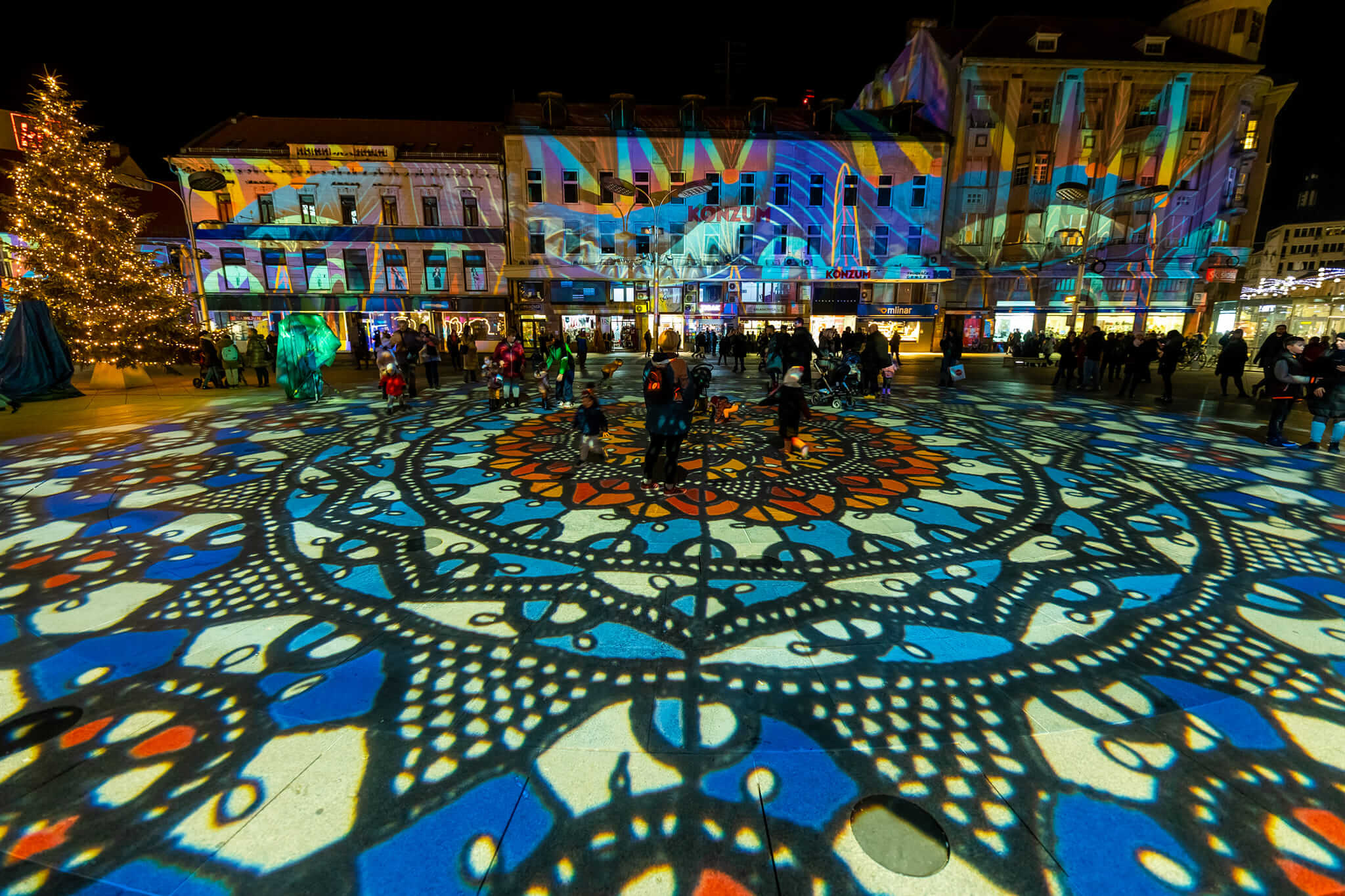 © TZ Grad Osijek
© TZ Grad Osijek
In recent times, Osijek's Ante Starčević square has seldom looked so thrilling. It is a wide and open city square - the only place in Osijek where the city tram lines all meet. Except for one modern sculpture and a statue of Ante Starčević, the square is floored with featureless concrete. The fine facades of surrounding Austro-Hungarian buildings have seen better years. In many instances, these historic frontages are cheapened by gaudy branded signage and advertisements.
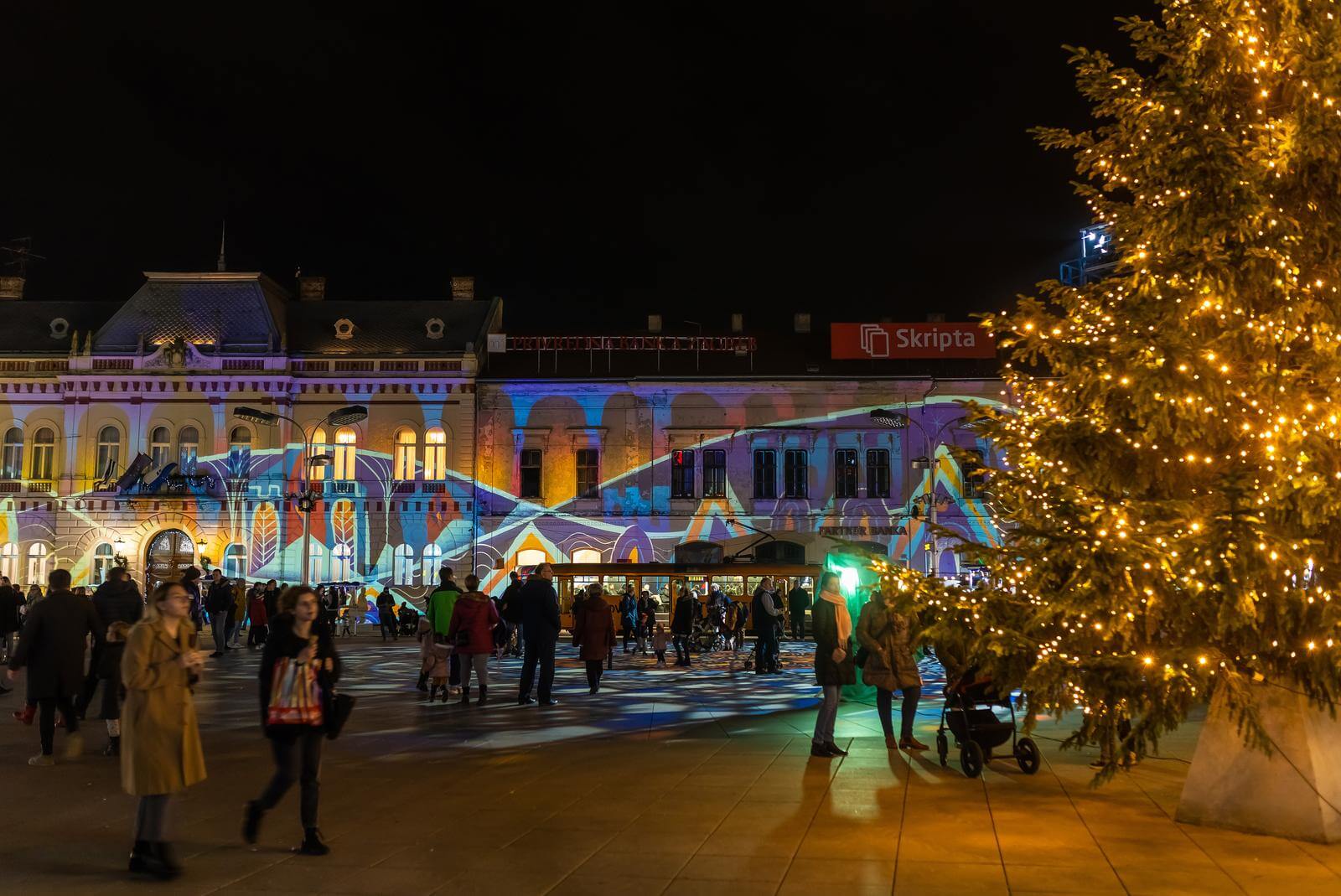 © Davor Javorovic/PIXSELL
© Davor Javorovic/PIXSELL
But, tonight, all the unsightly modern scars were hidden as an ocean of patterns and colours danced across the square. Children skipped along new pathways created by the brilliant lights' design. Now in its third year, these bright embellishments are part of the Kaleidoscope Festival of Lights. The arrival of its magical scenes heralds not only the start of this year's Osijek Advent but also marks Osijek City Day 2021.
Osijek City Day - 2 December
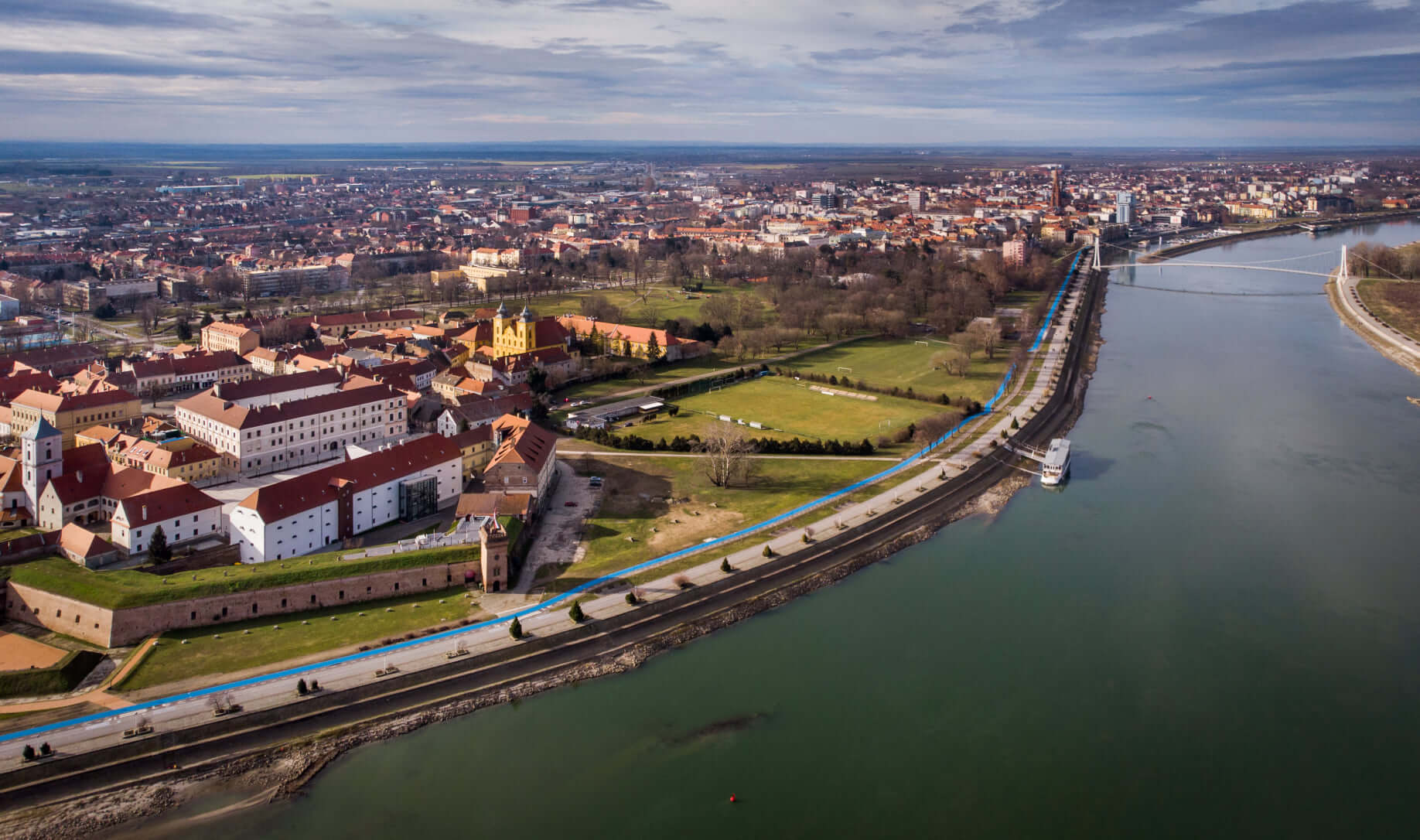 From above, Osijek's Tvrda and the Drava river © Mario Đurkić / Horizont solutions / TZ Grad Osijek
From above, Osijek's Tvrda and the Drava river © Mario Đurkić / Horizont solutions / TZ Grad Osijek
People have lived on this part of the Drava river for millennia. But, quite often, the modern life of Osijek city is only viewed as having begun after the Ottomans were removed by the Battle of Mohács. From 1687, Osijek and the eastern part of Croatia were part of the Habsburg Empire. But, Osijek remained close to the border of the new encroachment on Ottoman territory. Defensive fortresses were built along this line of defence, in Stara Gradiška, Osijek and Slavonski Brod in Slavonia and in Petrovaradin in Syrmia/Srem (Serbia).
Today, Osijek's fortress - Tvrđa – contains the largest collection of Baroque buildings in Croatia. It is a fantastic and picturesque location. There, Osijek's old city walls spectacularly overlook the Drava river. But, back when the city's defence was all-important, these walls made it difficult for Osijek to expand. Progress and growth proved impossible to hinder and, with the threat of the Ottomans becoming ever smaller, the population of Osijek simply began to settle outside the walls of Tvrđa. Indeed, today, residents of the city regard Osijek as having three centres – Lower Town, Tvrđa and Upper Town aka Ante Starčević square.
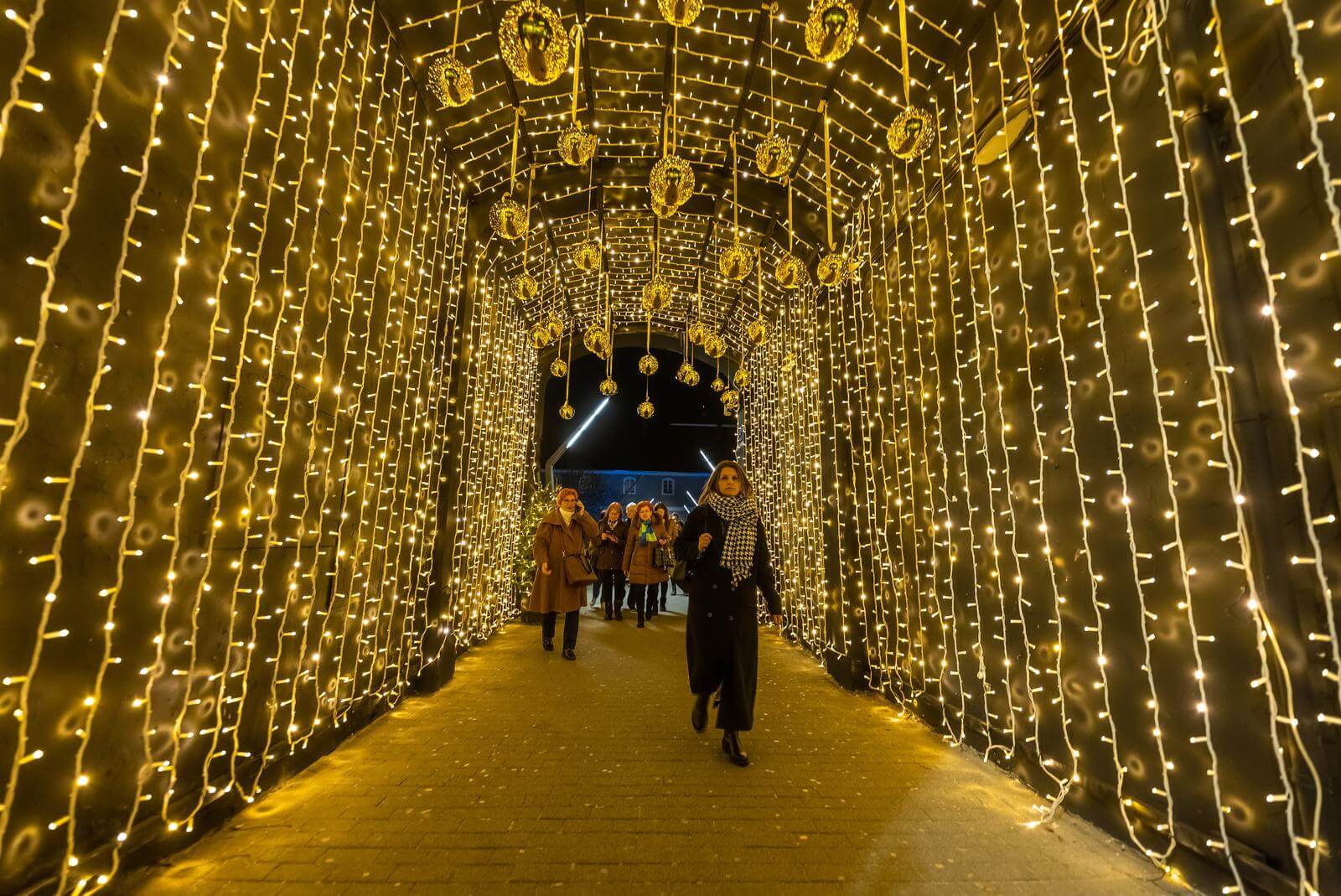 Lights in Upper Town turned on as part of Osijek City Day 2021 © Davor Javorovic/PIXSELL
Lights in Upper Town turned on as part of Osijek City Day 2021 © Davor Javorovic/PIXSELL
At the beginning of the 18th century, separate magistrates resided over Osijek's Lower and Upper Towns, effectively marking them as independent city municipalities. In order to gain status as a free and royal city, local authorities were eventually persuaded to unify the different municipalities on 2 December 1786. Since then, 2 December has been celebrated as Osijek City Day.
Kaleidoscope Festival of Light and Osijek Advent 2021
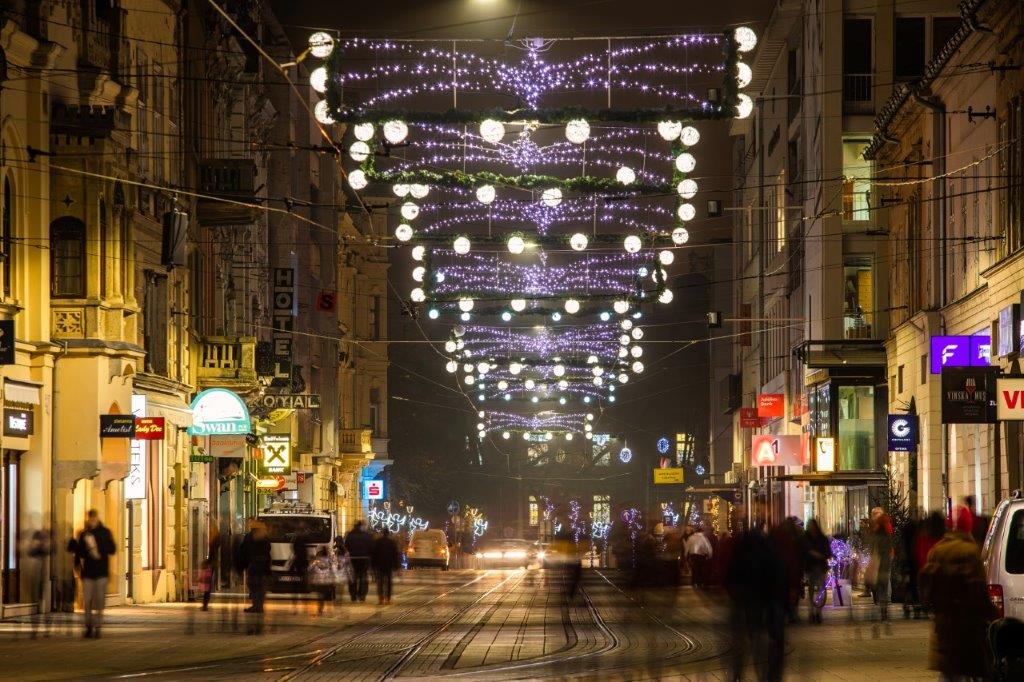 © TZ Grad Osijek
© TZ Grad Osijek
The incredible light show on Ante Starčević square is just one part of an Advent manifestation that, like the city itself, stretches long down the side of the Drava river.
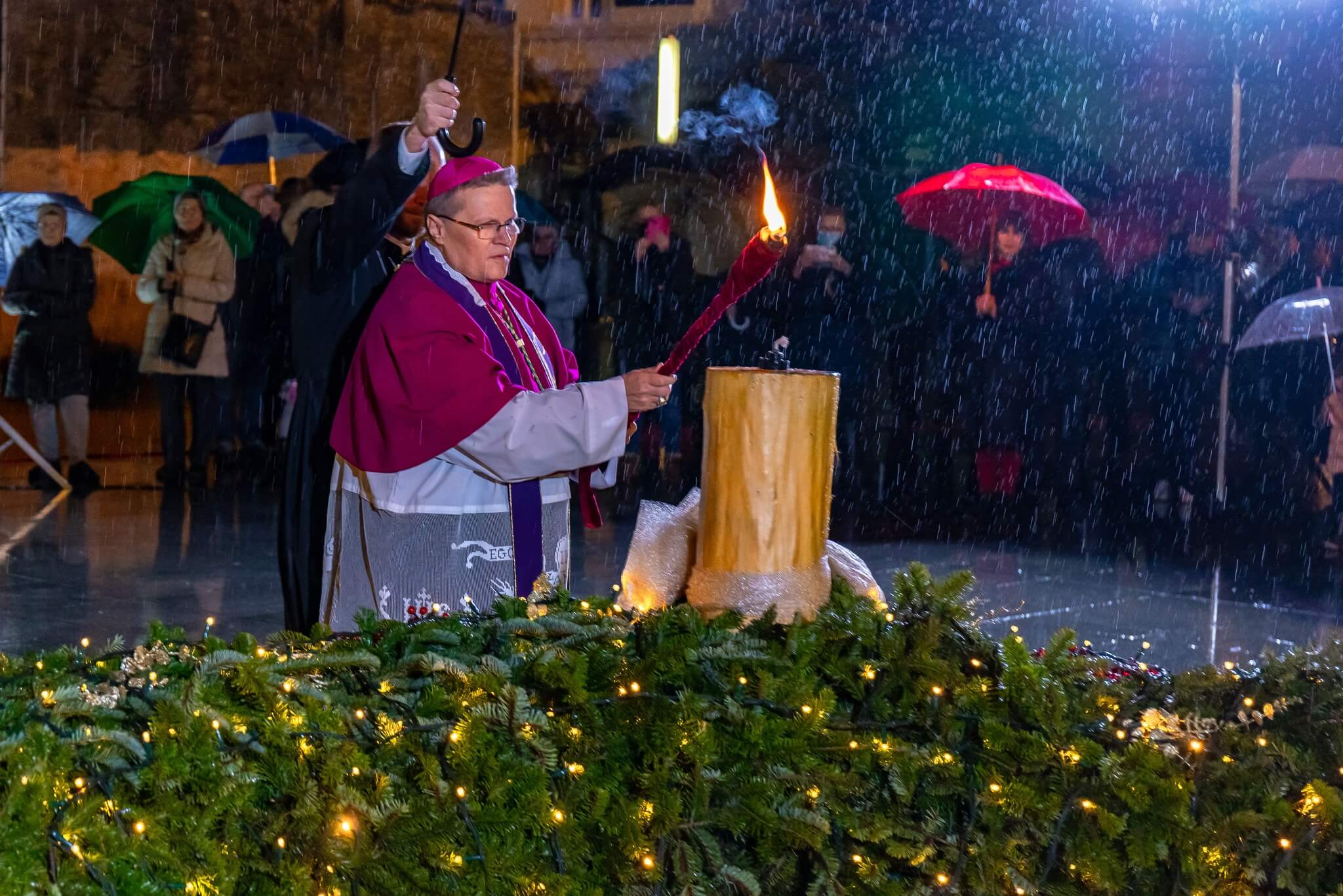 © TZ Grad Osijek
© TZ Grad Osijek
The first candle of Advent 2021 was lit by the Archbishop of Đakovo-Osijek Đuro Hranić on Sunday 28 November. Osijek City Day celebrations are the second key milestone of the Christmas holiday season. City-wide Christmas lights were formally turned on today at the Croatian National Theatre Osijek.
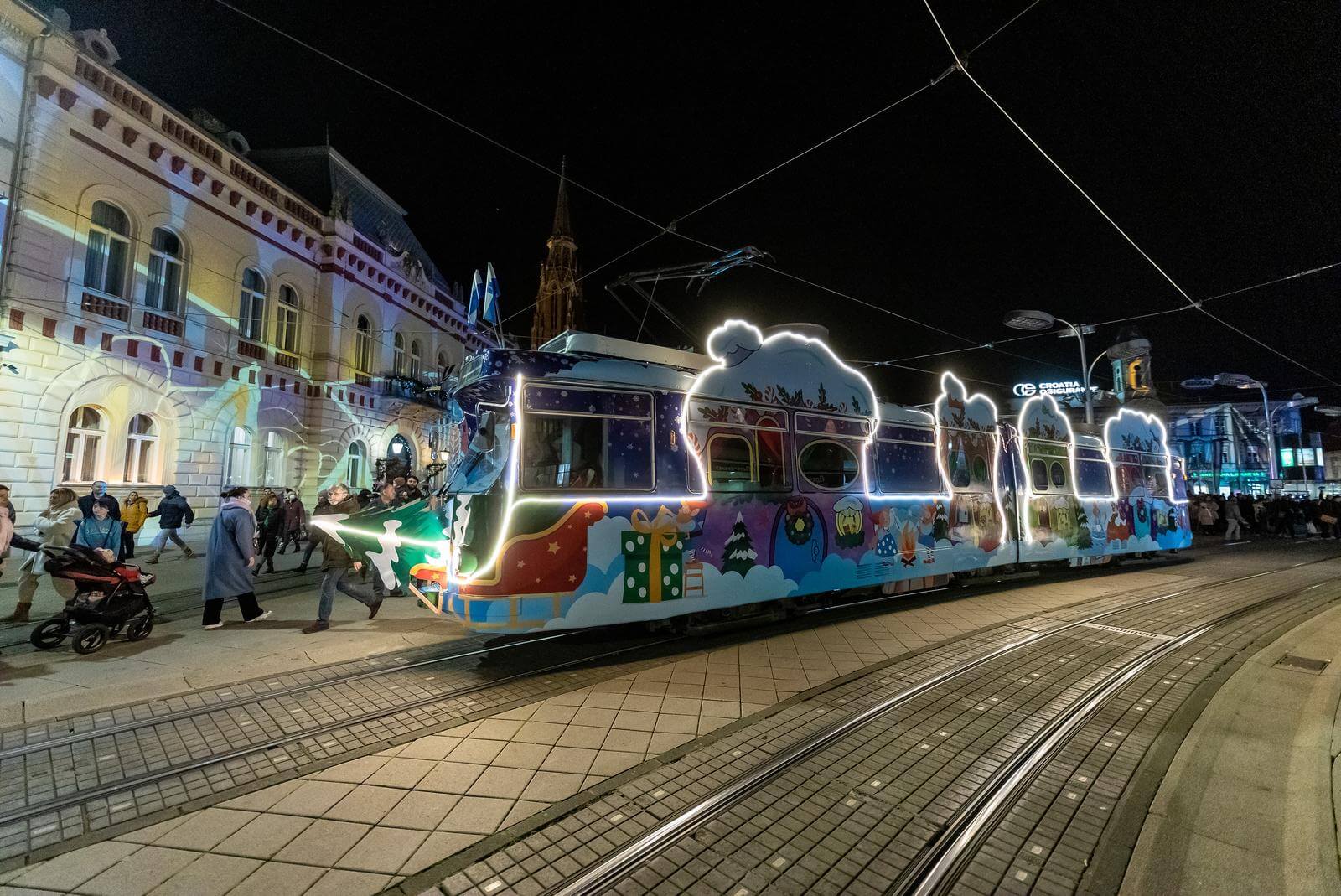 © Davor Javorovic/PIXSELL
© Davor Javorovic/PIXSELL
Osijek Advent 2021 includes the return of the Kaleidoscope Festival of Light and Osijek Advent Tram - which is visited by almost 15,000 people each season. Christmas lights extend down European Avenue, passing some of the city's most grandiose Austro-Hungarian architecture. Thereafter, the trail comes 'off road' and takes you through the trees of King Tomislav Park. Next, Tvrđa assumes the focal point of Advent, with a Winter Lookout on the roof of the Cultural Centre, the Museum of Fine Arts, the Sokol ice rink and the tallest Ferris Wheel in Croatia being key highlights.
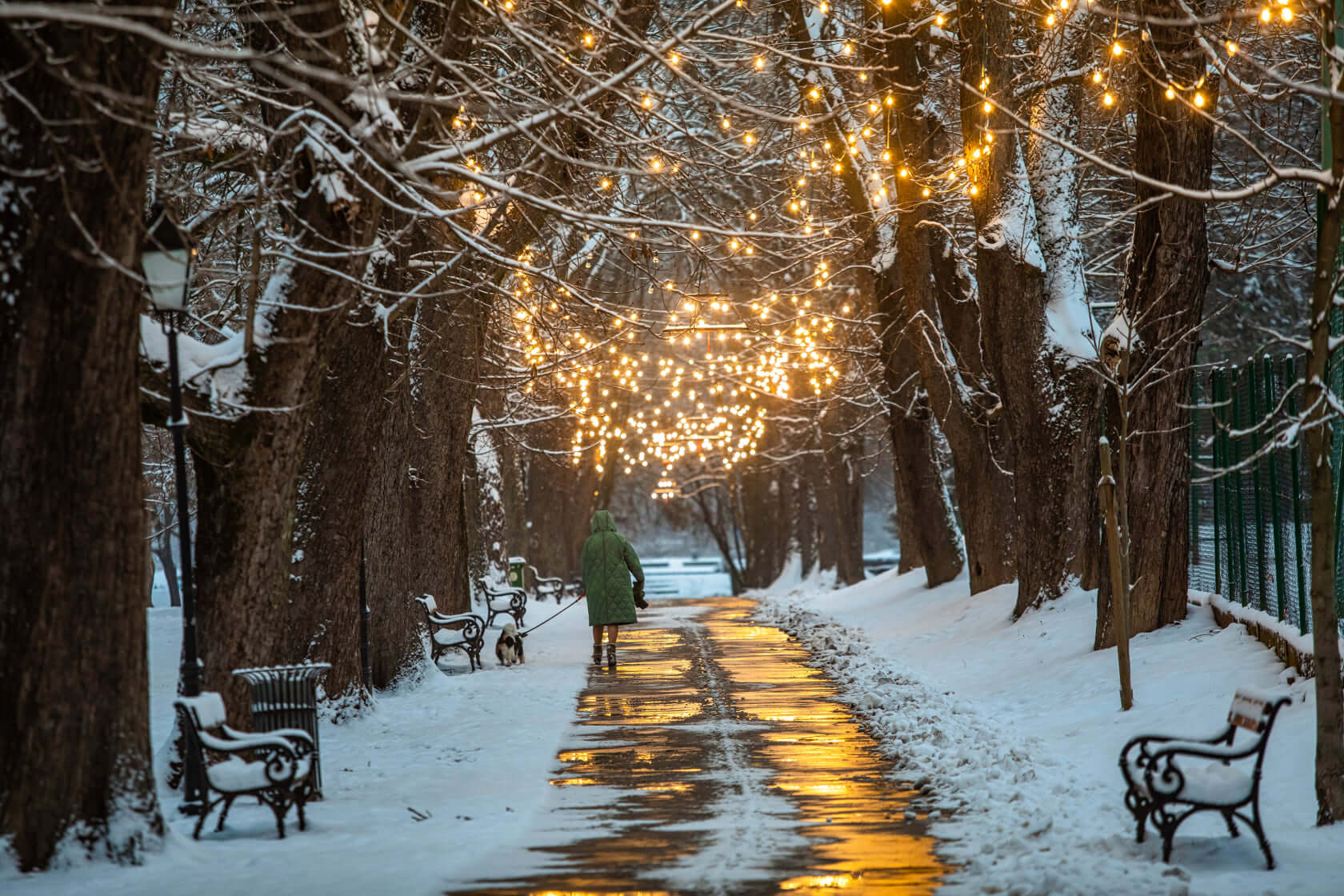 Photo from Osijek Advent 2020 © TZ Grad Osijek
Photo from Osijek Advent 2020 © TZ Grad Osijek
If you want to read more about Osijek, see the Total Croatia guide here. And, if you want to keep up with news from Osijek, bookmark Total Croatia News's Osijek pages here
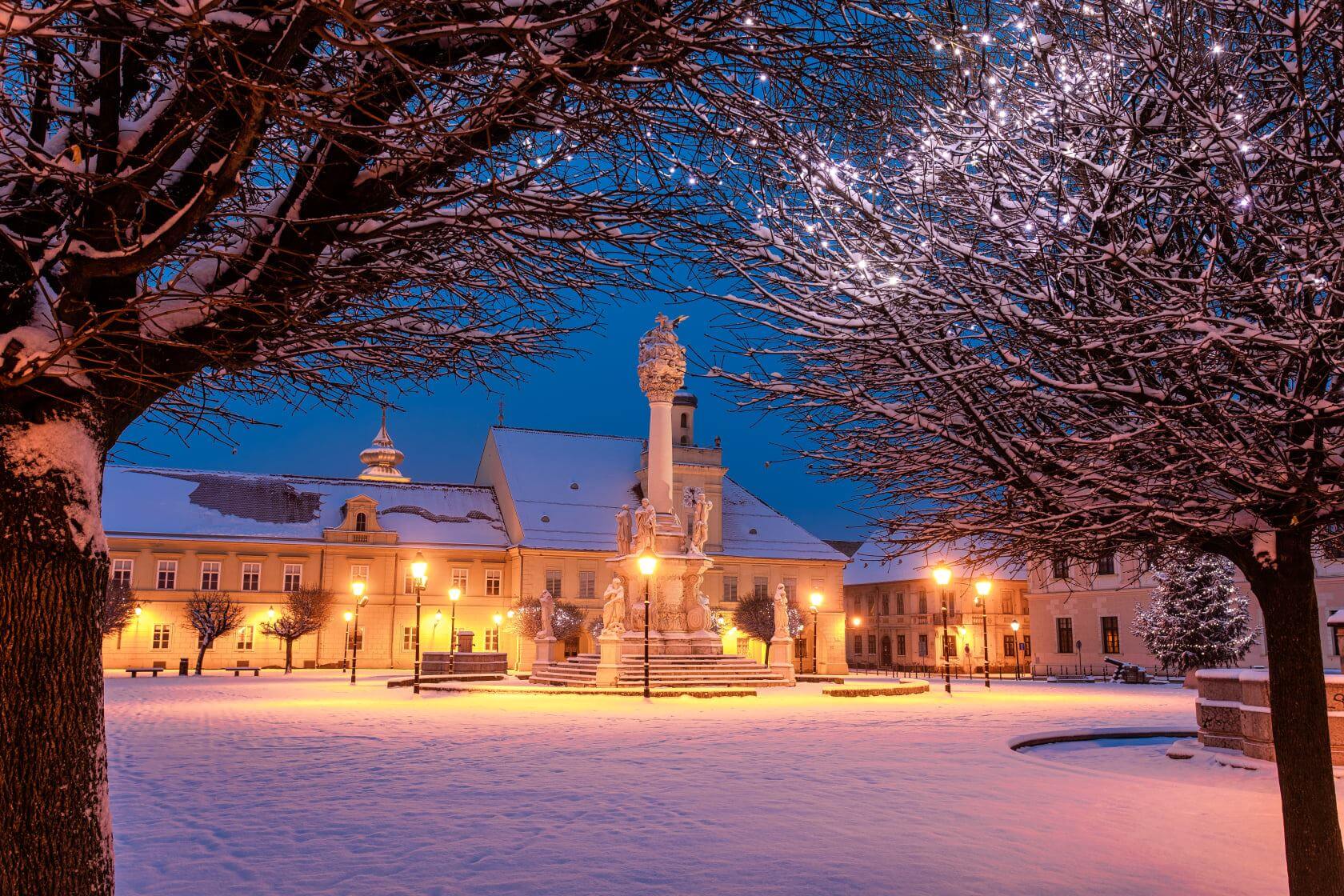 Photo from Osijek Advent 2020 © TZ Grad Osijek
Photo from Osijek Advent 2020 © TZ Grad Osijek
Croatia Holding Election Runoffs on Sunday
ZAGREB, 29 May 2021 - The second round of local elections will take place on Sunday for the mayors of 57 cities and 87 municipalities as well as for the prefects of 14 counties in Croatia.
During the second round of voting, 3,231,000 citizens are eligible to vote at nearly, 5,500 polling stations that will be set up in 432 cities and municipalities.
Four biggest cities to get new mayors
The results of mayoral runoffs will show who will run the four biggest Croatian in the next four years. In the capital city of Zagreb, the mayoral candidate of the Green-Left Coalition, Tomislav Tomašević of the We Can party faces off Miroslav Škoro of the Homeland Movement party (DP), whereas in Split, the mayoral runoff includes Vice Mihanović of the Croatian Democratic Union (HDZ) and Ivica Puljak of the Centre party.
In Rijeka, Marko Filipović of the Social Democratic Party (SDP) and independent Davor Štimac are vying for the mayoral of this northern Adriatic seaport, and in Osijek, Ivan Radić of the HDZ and Berislav Mlinarević, supported by the DP party and the Bridge party, are running in the mayoral runoff.
Those four cities will have new mayors, as none of the incumbents are in the mayoral race. In Zagreb Milan Bandić, who was at the helm of the city for 20 years, died of heart attacks on 28 February.
The outgoing mayors of Osijek and Split, Ivica Vrkić and Andro Krstulović Opara (HDZ), decided not to run for a new term, citing health reasons.
The outgoing Rijeka mayor Vojko Obersnel, an SDP official, who has been at the helm of Rijeka since 2000, said before these local elections that the time had come for younger politicians to take the helm and supported Marko Filipović of the SDP as his successor.
Another major cities, which are county seats, for instance Varaždin, Dubrovnik, Vukovar and Sisak will have the mayoral runoffs between the incumbents and the new opponents.
In Pula, which was run by Boris Miletić of the Istrian Democratic Party (IDS) until these polls, the IDS official Helena Puh Belci faces off independent candidate Filip Zoričić.
Six counties get prefects in 1st round, 14 to have runoffs
Six counties elected their prefects in the first round of voting on 16 May, when the winners won more than 50% of the ballot, and the remaining 14 counties will have runoffs for their prefects on Sunday.
Of those six winners in the first round, four are HDZ representatives: Antonija Jozić of Požega-Slavona, Igor Andrilović of Virovitica-Podravina County, Ivan Anušić of Osijek-Baranja County and Danijel Marušić of Slavonski-Brod Posavina County.
Social Democrat (SDP) official Željko Kolar was reelected prefect of Krapina-Zagorje County and Matija Posavec, an independent candidate, was reelected as the head of Međimurje County.
In the other 14 counties, the first two vote-getters will participate in the runoffs on 30 May.
Anti-epidemic measures to be implemented at polling stations
Voters going to the polls on Sunday are required to wear protective masks and they are also advised to have their own pencils. Although the epidemiological situation has improved since the first round of the voting, the same anti-epidemic measures will be implemented on Sunday.
Polling stations open from 7 am to 7 pm
The polling stations will open on 7 am and close at 7 pm. The course of voting will be observed by 8,334 monitors, and the lion's share of them have been proposed by political parties running in the elections, while a mere 17 monitors will be at polling stations on behalf of nongovernmental organisations
Remains of Five Victims Who Went Missing in War Identified in Osijek
ZAGREB, 21 May 2021 - Five people, whose remains were unearthed in Croatia's Danube region after they had gone missing in the 1991-1995 Homeland War, were identified in an Osijek hospital's forensic department on Friday.
Prime Minister Andrej Plenković, accompanied by War Veterans' Affairs Minister Tomo Medved, attended the final identification and after that he told the press the government was committed to shedding light on the fate of all the war victims.
Plenković said that the issue of missing victims was raised on every occasion and at every formal and informal meeting with Serbia's representatives.
Minister Medved said that Serbia still made no contribution to efforts to find the victims who went missing in the war.
After today' identification, the number on the list of missing people has fallen to 1,864. Of them, 401 are presumed to be dead and the fate of the remaining 1,463 victims is still unknown.
For more news in Croatia, follow TCN's dedicated page.
Osijek to Get Underpass, 13 Buses in Bid to Improve Public Transport System
ZAGREB, 21 May 2021 - Agreements on EU-funded grants for the construction of an underpass and for the procurement of 13 new buses for public transportation system in Osijek were signed on Friday in that eastern Croatian city.
In attendance at the ceremony was Prime Minister Andrej Plenković who said that the 93-million-kuna underpass in S. Leopolda Bogdana Mandića Street would reduce traffic jams in that part of the city.As high as 85% of this investment will be covered by the European Union's funds while the remaining 15% will be covered by the state budget.
Also, 32 million kuna will be set aside for the procurement of 13 new buses for public transportation. The 85% of the amount is also covered by funds from the EU.
All these projects are part of our policy which we have been pursuing since 2016 as part of the "Slavonia, Baranja and Srijem" project, and we have contracted 17.7 billion kuna under that programme, Plenković said.
The outgoing mayor Ivan Vrkić said that during his two mayoral terms, HRK 1.6 billion had been invested in Osijek since Croatia joined the European Union.
(€1 = HRK 7.508080)
For more on travel in Croatia, follow TCN's dedicated page.
HNS Presents Its Candidate for Osijek Mayor
ZAGREB, 21 March 2021 - The parliamentary Croatian People's Party (HNS) on Sunday presented its candidate for Osijek mayor, the head of the party's branch in that eastern Slavonian city and former deputy mayor, Vladimir Ham.
HNS leader Stjepan Čuraj said Ham knew how the city operated and how concrete political initiatives at the local level were shaped as well as that he was a deputy mayor during the first term of Mayor Ivan Vrkić, when numerous projects were launched.
Ham said that he wanted to open Osijek to young people "because we can see that the city has been developing in an entirely new direction, including IT industry. We do not want to build factories but rather create conditions for people with ideas, who want to work and know exactly what they are doing," Ham said, among other things.
Local elections are to be held on May 16.
For more about politics in Croatia, follow TCN's dedicated page.
Syrian Migrant Family Rescued from Inaccessible Slavonia Wetlands
February 13, 2021 – Osijek-Baranja police rescued a Syrian migrant family, including two children, from inaccessible Slavonian wetland terrain. They had become cut off and stranded on an island, surrounded by swollen waters
Osijek-Baranja police have rescued a Syrian migrant family, including two children, from inaccessible Slavonian wetland terrain, police revealed in a statement released on Saturday 13 February. They had become cut off, surrounded by swollen waters, in the area around Kopacki rit Nature Park.
At around 10 a.m. Friday 12 February, in a forest area near Aljmaš, police found a 19-year-old Syrian citizen during a regular patrol. The 19-year-old asked for police help because his family was cut off on a river island of Kopački rit.
Immediately after learning about the other members of the Syrian migrant family, the police dispatched two patrol boats to look for them. They discovered the Syrian migrant family in a very short time. In addition to the teenager already discovered, police found the rest of the Syrian migrant family travelling party to include three women, born in 1973, 1998 and 1999, and two children, born in 2016 and 2017.
The found persons were transported to the mainland by the police. There, they were met by an ambulance, which had been called due to cold temperatures in the area and fears their exposure could have lead to hypothermia. They were transported to the Osijek Clinical Hospital Center (KBC).
The Syrian migrant family was released from the hospital later in the same day.
It has been established that the Syrian migrant family have expressed their intention to apply for international protection in the Republic of Croatia. They have been sent to the Shelter for International Protection Seekers, a reception centre for asylum seekers in Zagreb, said the police.
Kopački Rit, where the Syrian migrant family were rescued, is a nature park in the eastern Croatia municipalities of Bilje and Kneževi Vinogradi. It is located northwest of the confluence of the Drava and the Danube, right next to the border with Serbia. It is comprised of many backwaters, marshland and ponds that exist immediately between these two great rivers. It is one of the most important, largest and most attractive preserved intact wetlands in Europe.
For the latest travel info, bookmark our main travel info article, which is updated daily.
Read the Croatian Travel Update in your language - now available in 24 languages.
PHOTOS: Incredible Transformation of City Centre Osijek Art Nouveau Villa
January 16, 2021 – An incredible Osijek Art Nouveau villa, situated in the heart of the city centre, it took local entrepreneur Branko Ostović almost 10 years to buy the famous, decaying Villa Batory. In just 18 short months he has returned the building to its former glory
Every town has a grand old ruin. It's the place residents drive past and dream of owning. “If I had a million Euros, I'd buy that place, bring it back to its best and live like a king”
Croatia has more of these kinds of buildings than most. For hundreds of years these lands were presided over by elite European families and royalty who used their considerable wealth to build castles, stately homes, hunting lodges and villas. After the Second World War, such buildings were seized by the state and, for numerous reasons, many fell into disrepair. One such building was Villa Batory, a city centre Osijek Art Nouveau villa.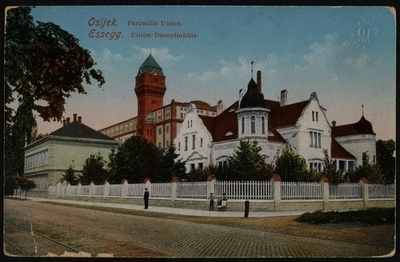 How Villa Batory originally looked, not long after its completion in 1906
How Villa Batory originally looked, not long after its completion in 1906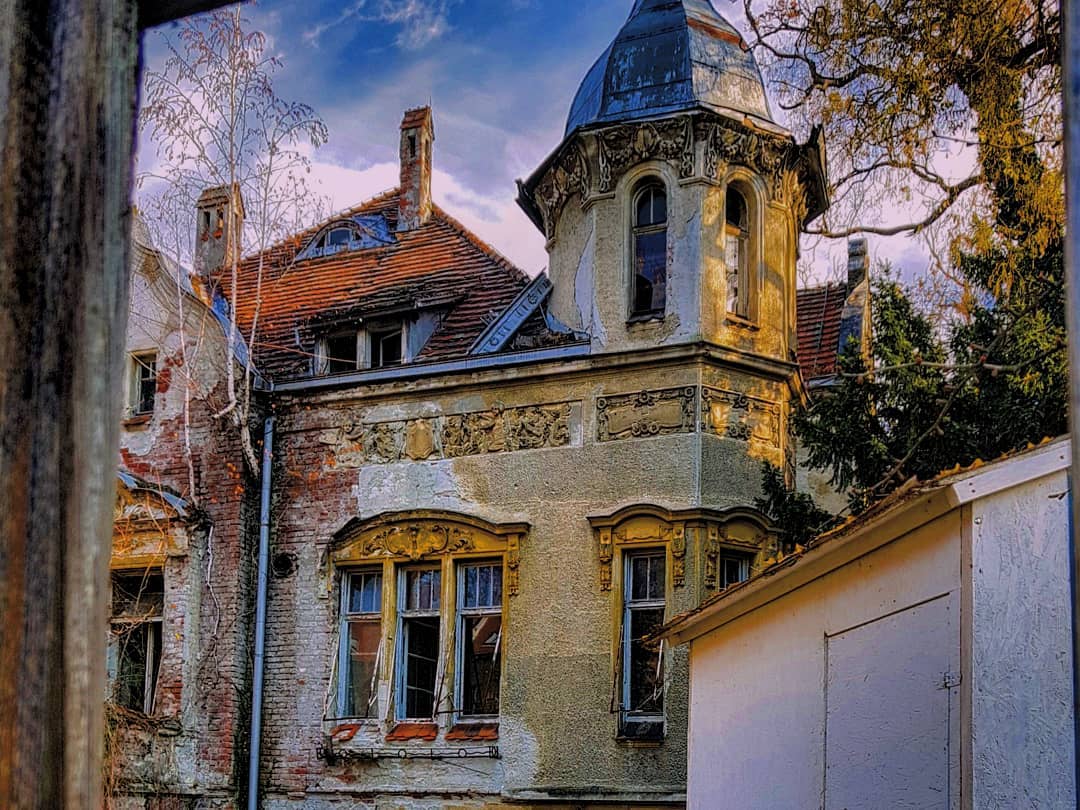 The state of disrepair the villa fell into over the last 20 years - it still looked impressive, if unloved © Dvorci, utvrde i stari gradovi Facebook / Aleksandra Petrović
The state of disrepair the villa fell into over the last 20 years - it still looked impressive, if unloved © Dvorci, utvrde i stari gradovi Facebook / Aleksandra Petrović
For over 20 years, this incredible Osijek Art Nouveau villa has lain empty. Prominently positioned on the corner of Radićeva and Reisnerova streets, right in the heart of Osijek, the building has drawn admiring stares ever since it was built in 1906. Even while empty and left slowly decaying, its impressive towers, intricate stone and plasterwork and considered architectural details ensured this Osijek Art Nouveau villa was never far from the daydreams of anyone who walked by.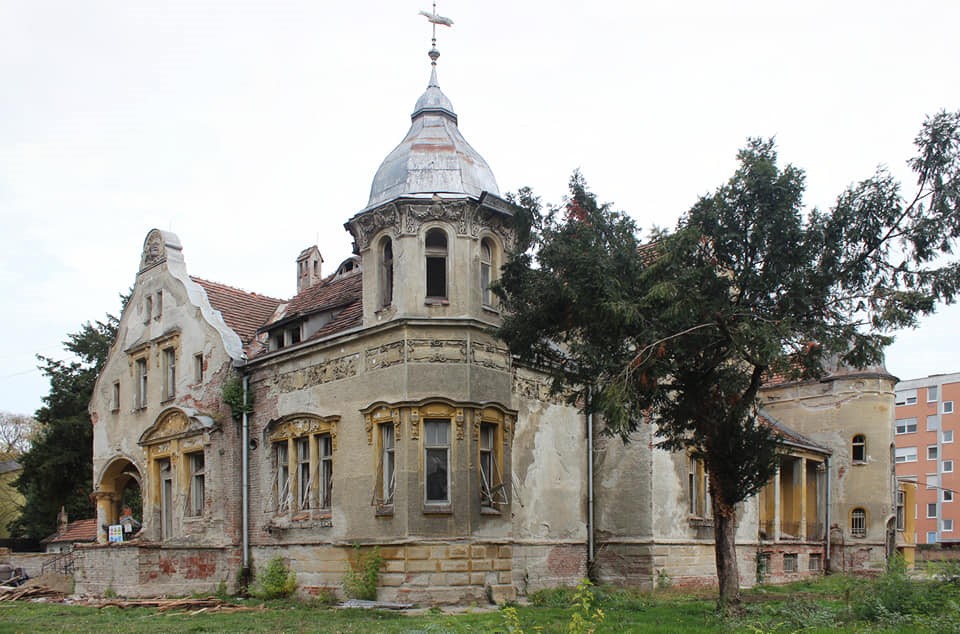 An incredible architectural gem, wasting away, until now... © Croatian Heritage Facebook
An incredible architectural gem, wasting away, until now... © Croatian Heritage Facebook
One such daydreamer was Branko Ostović. Only, being one of Osijek's successful entrepreneurs, Branko has perhaps more get-up-and-go than many idle dreamers. For him, daydreams were simply not enough. For almost 10 years he tried to negotiate the purchase of the receding Osijek Art Nouveau villa. Progress was difficult, given the listed nature of the property, past disputes over ownership and the building lying within the ownership of the local hospital, who had no funds to renovate and required state permission to sell.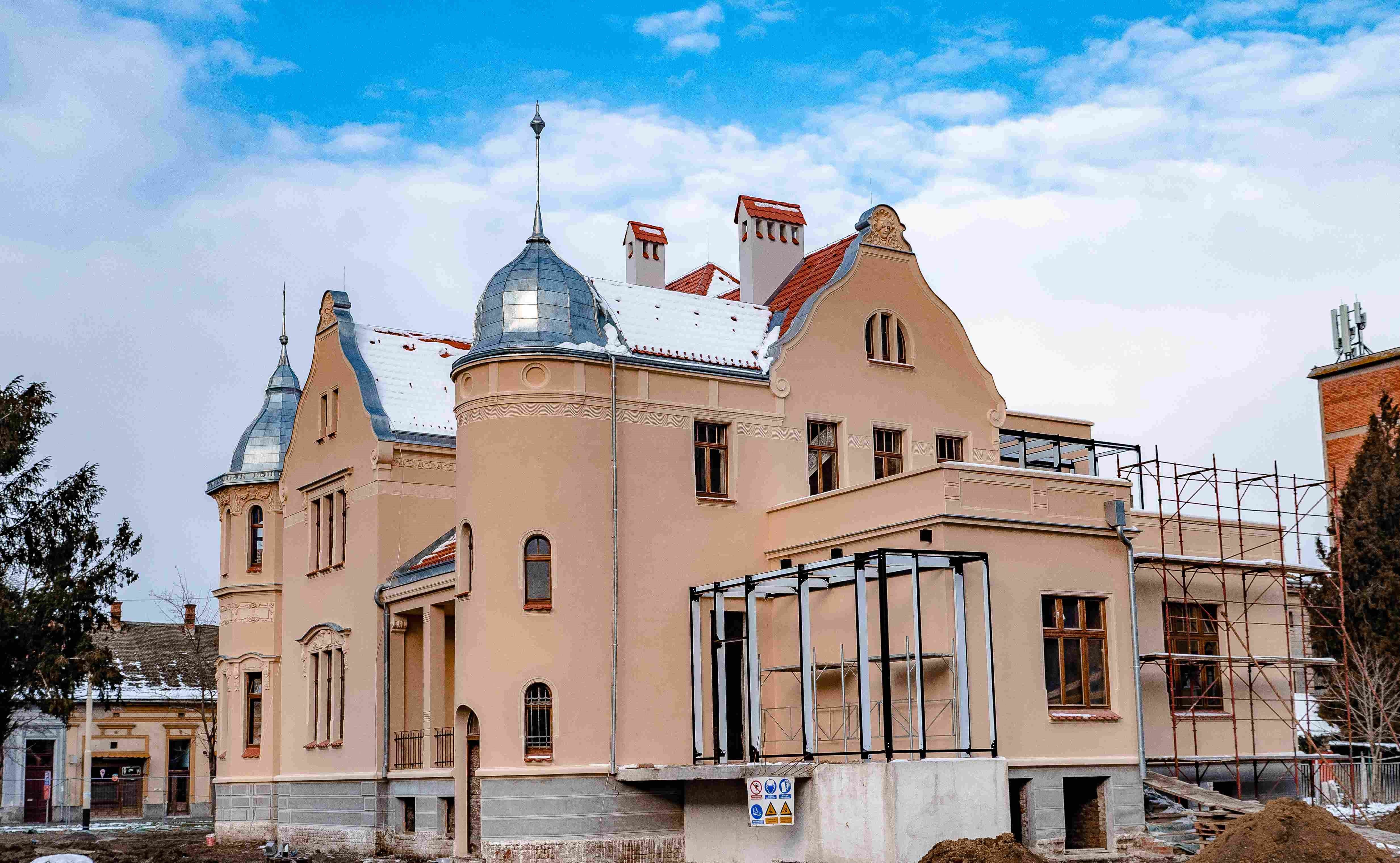
Finally, in 2019, Branko Ostović successfully assumed ownership of the Osijek Art Nouveau villa. In just 18 short months – and a considerable financial investment – he has not only halted the building's decline but has restored its outer facade so that Osijek residents can once again take pride, rather than pity, in this city centre architectural gem. He has renamed the villa 'Mimi', after his wife, a popular local teacher.
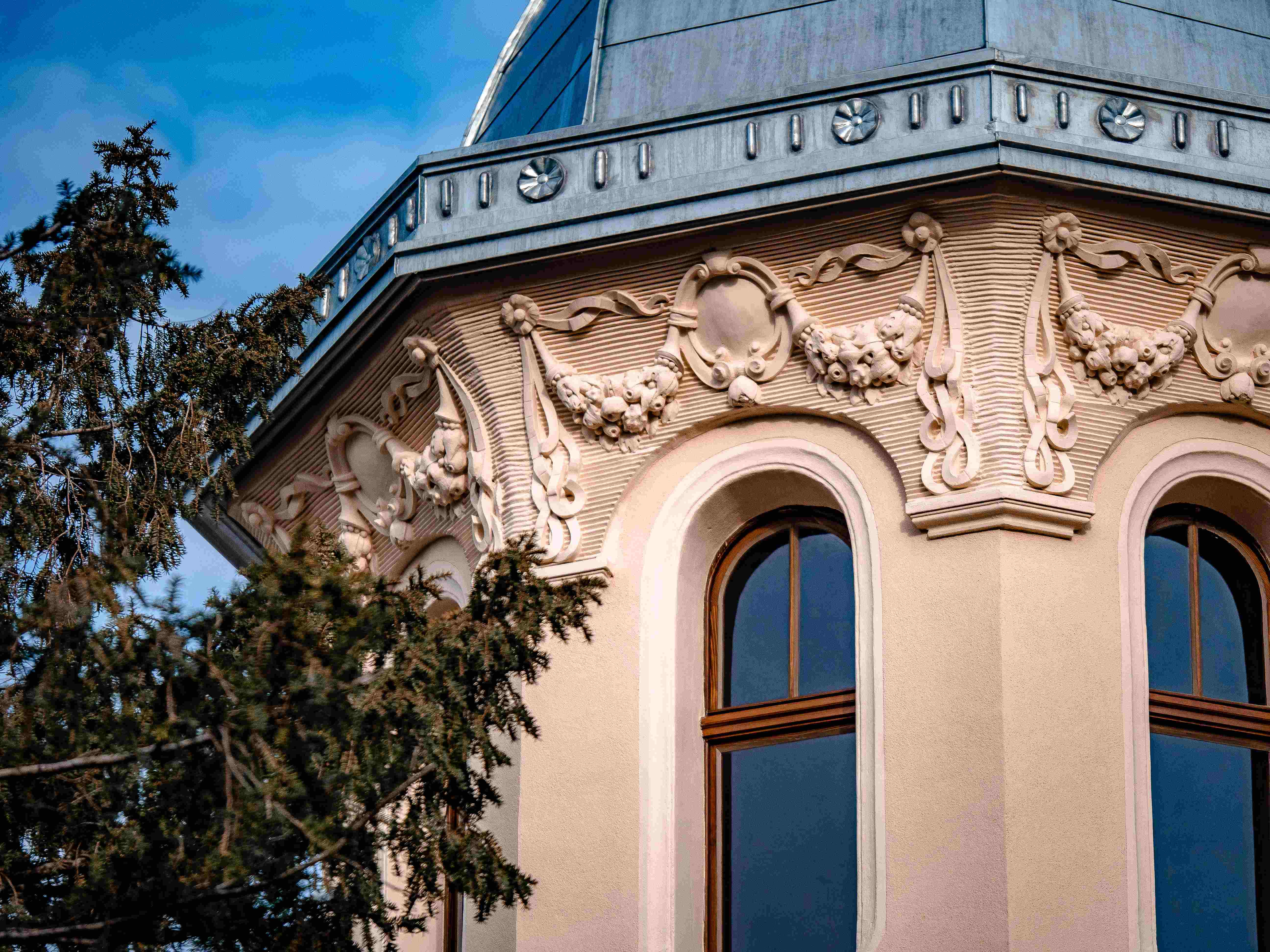
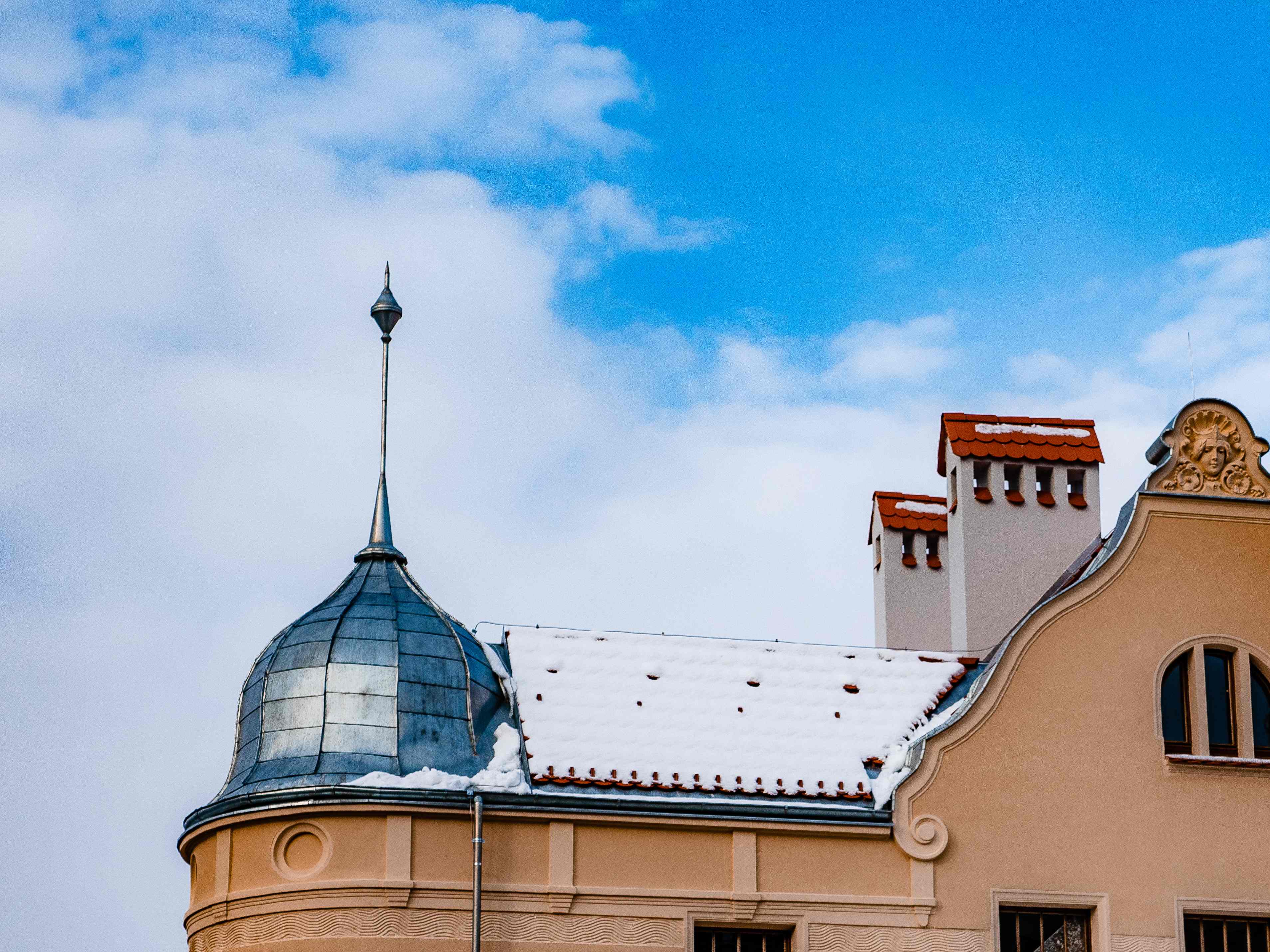
The villa exists within grounds that cover an enormous 3000 square metres. This is a considerable tract of land, given it is right in the heart of the city. It was built in 1906 as the villa of the manager of Paromlin Union (one of the largest mill plants in the area) by noted Osijek builder Otto Struppi. It is just one of a series of art nouveau gems that lie in this westerly section of the city.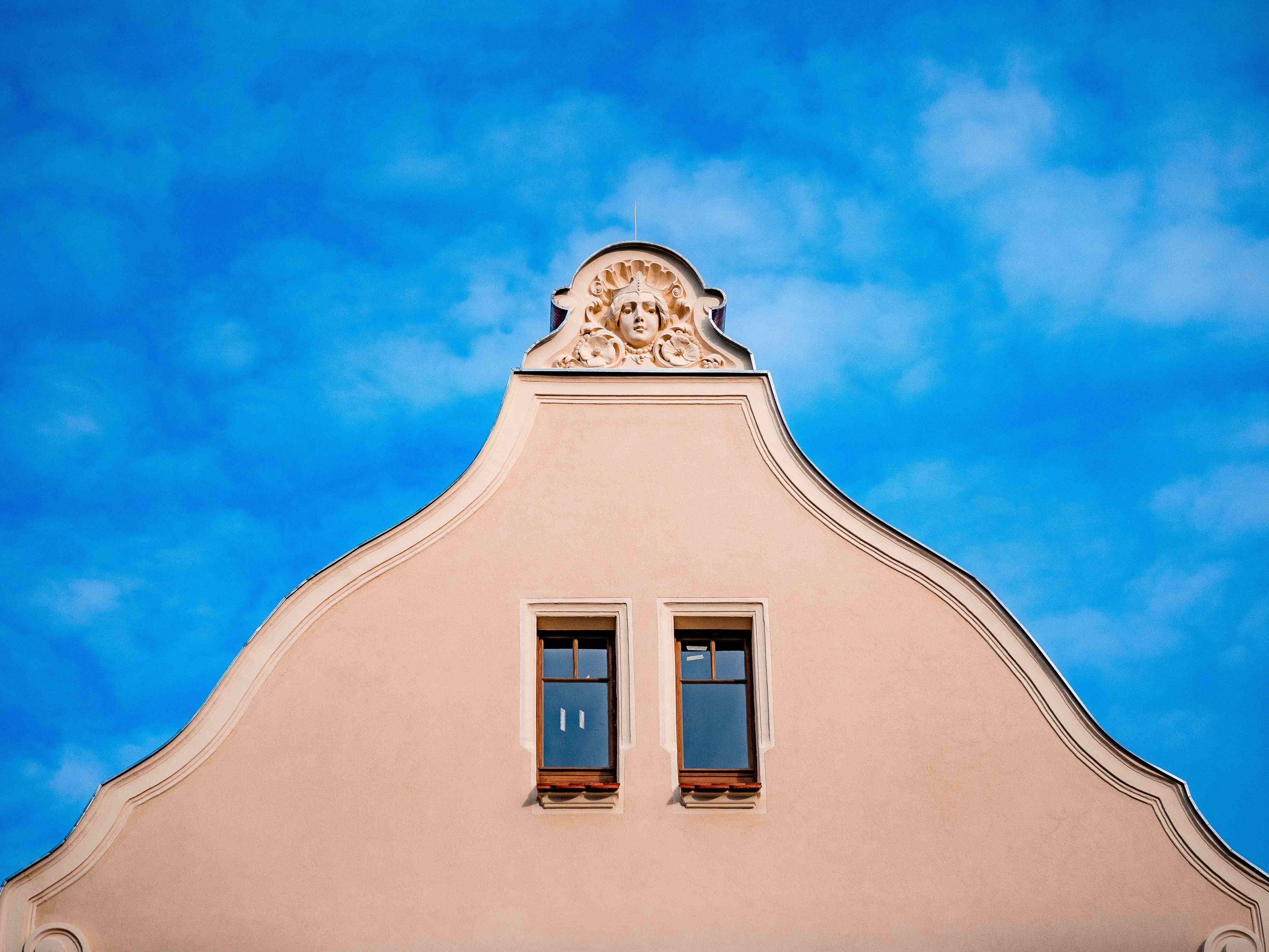
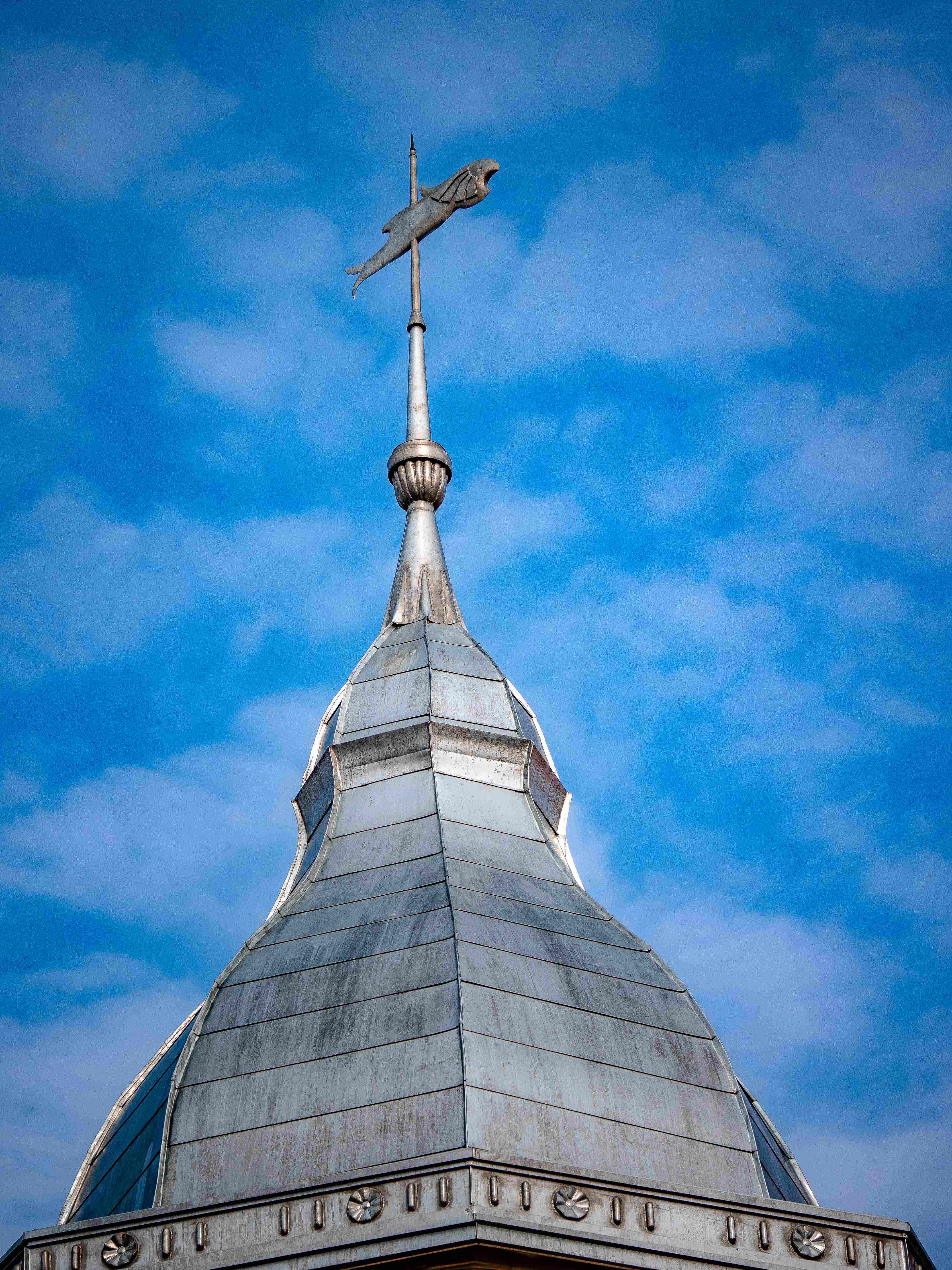

Throughout his attempts at purchasing the building, Branko Ostović had no real commercial plans of what he could do with the building. Recognised for its architectural worth, there are restrictions imposed by the state on how any renovation may treat the property. The interior cannot be altered in a way that would the property better suited to contemporary living accommodation. Ostović's main motivation for buying it was simply to stop the rot and return it to its former glory.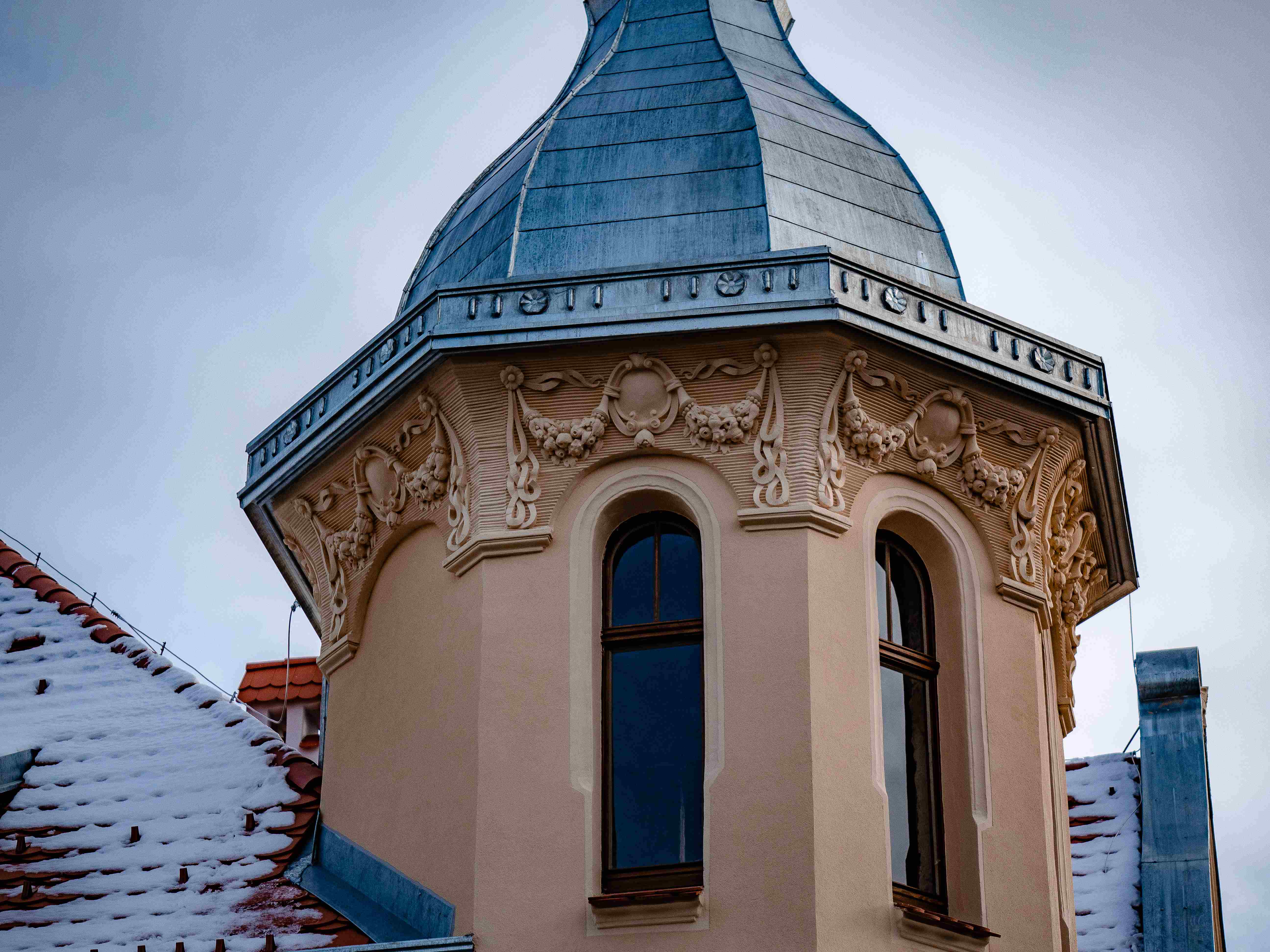
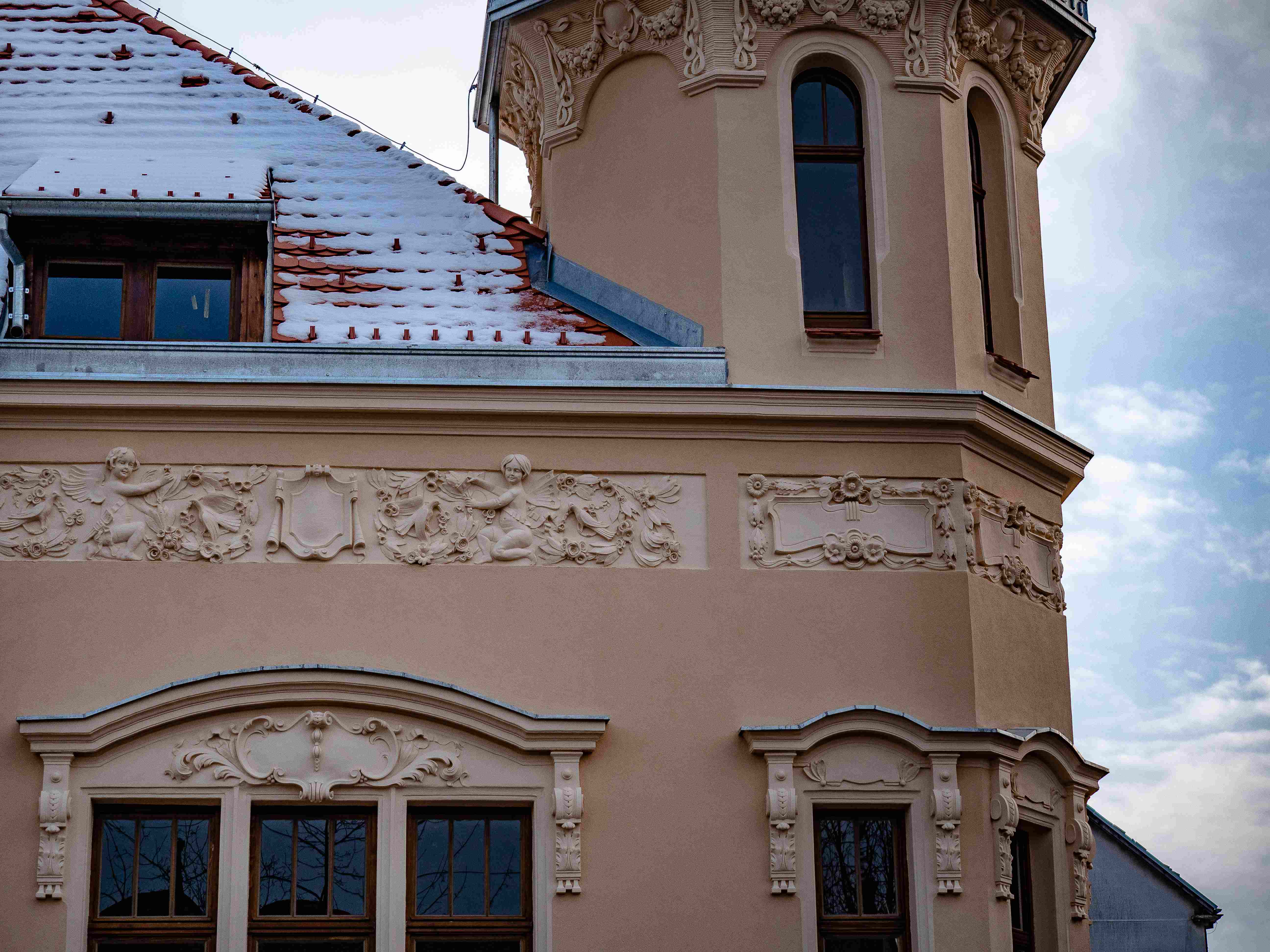
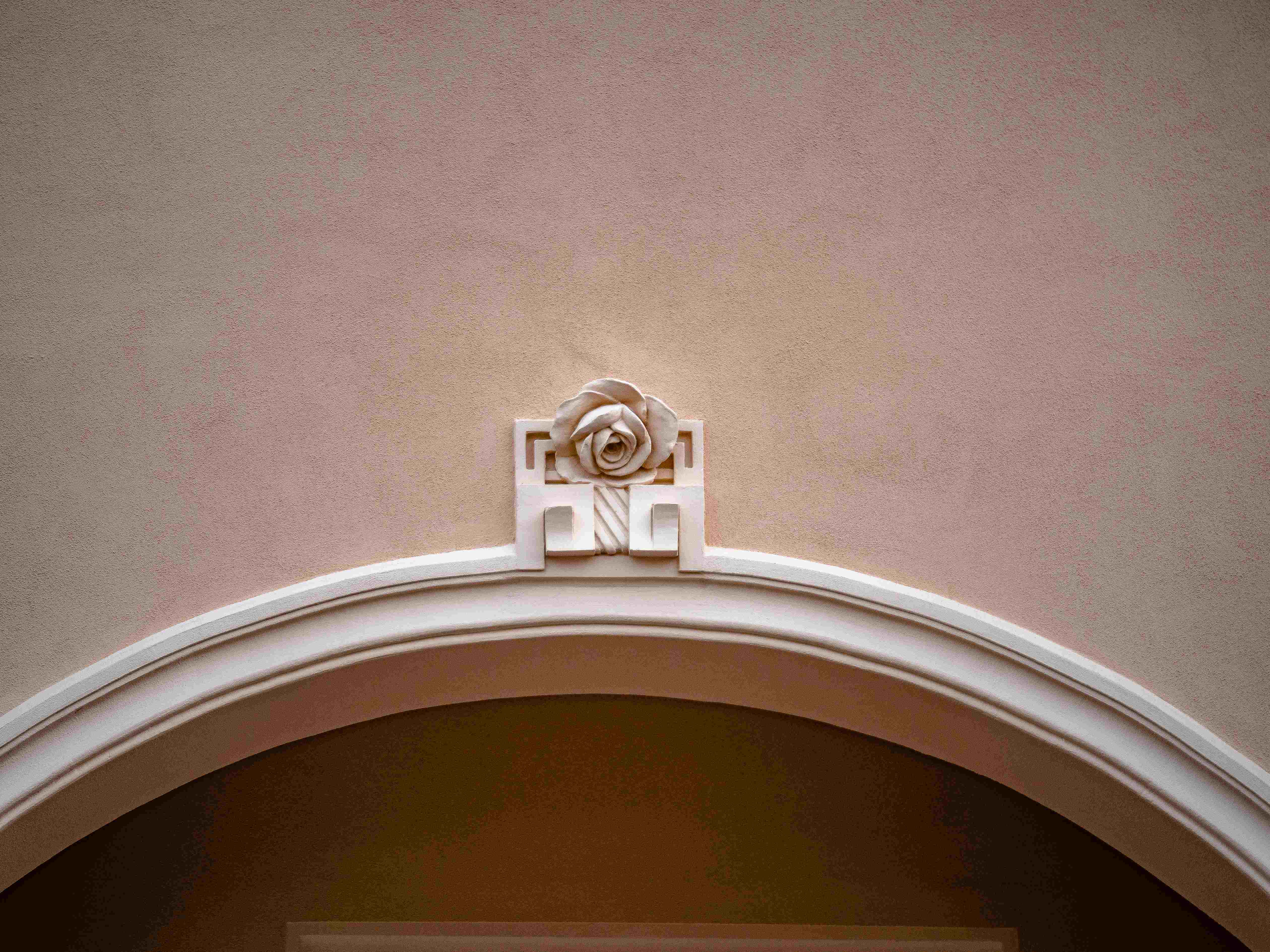
He has so far invested some 40 million kuna in the restoration and 5 million kuna in the initial purchase. 95% of work on the exterior is complete, although further investment is needed for the interior. Focussed on completing the long-held project, Ostović still has no clear plans for the building and no potential tenants. He imagines the Osijek Art Nouveau villa might make a good home for a polyclinic or a hotel.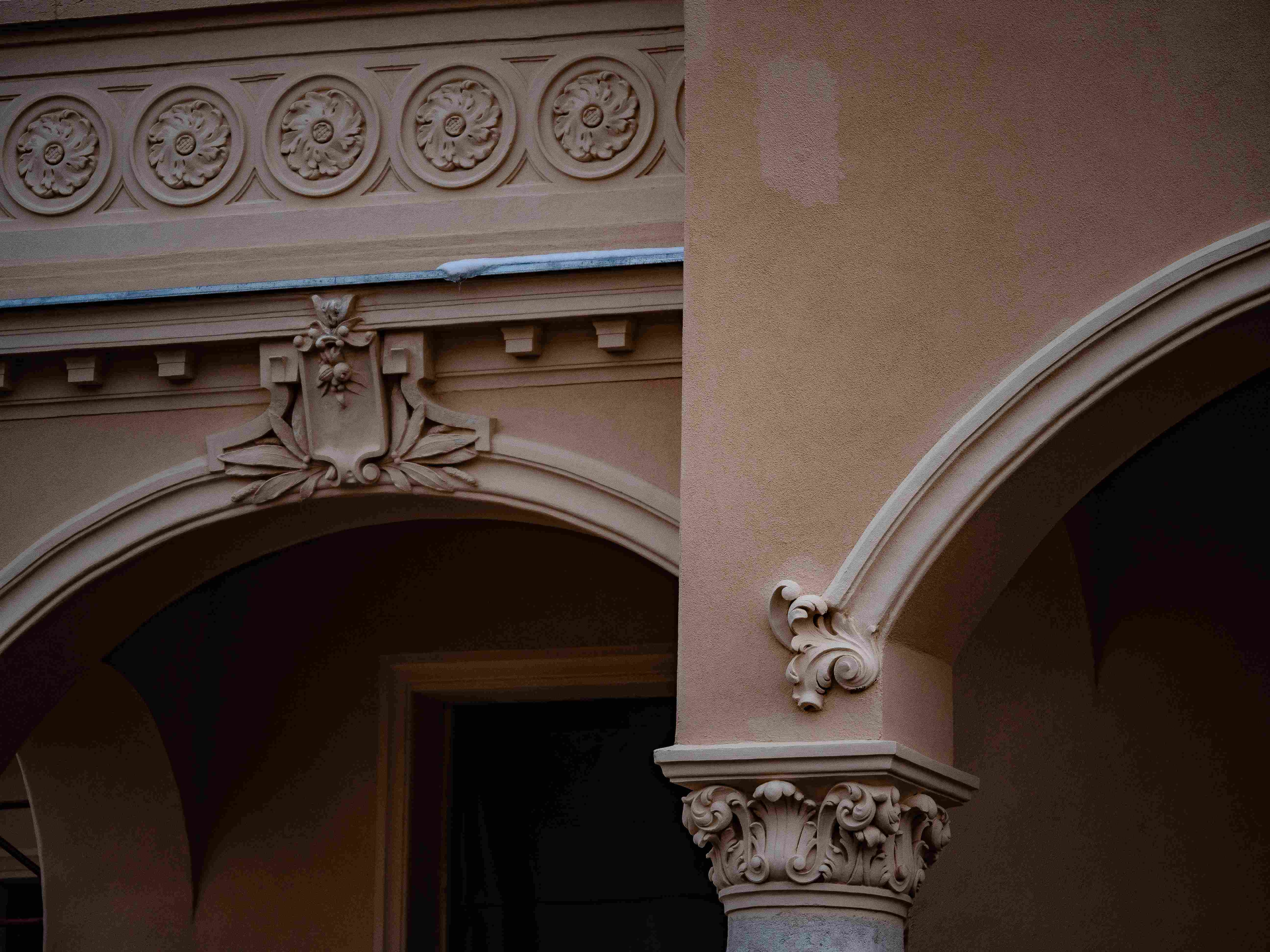
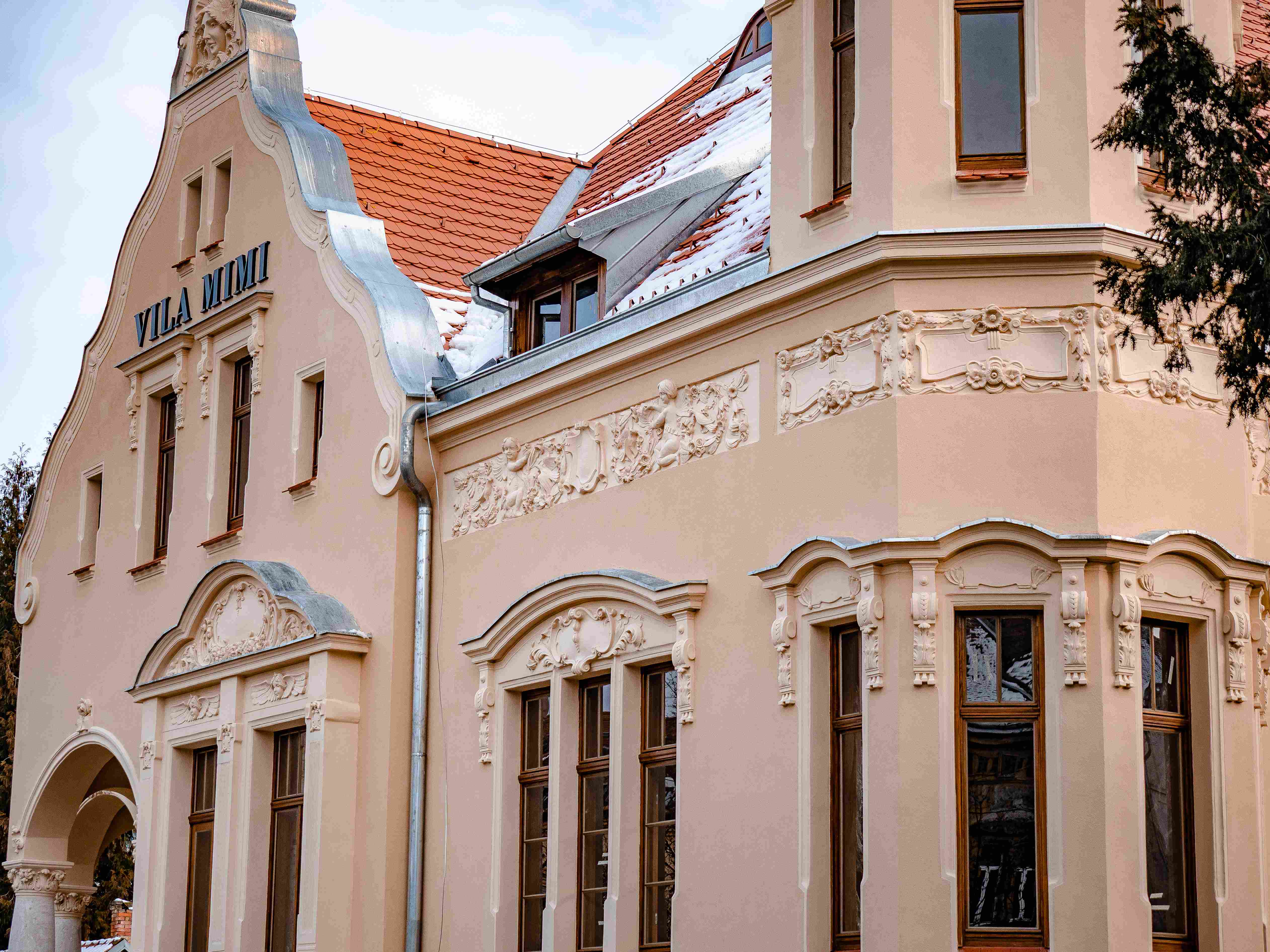

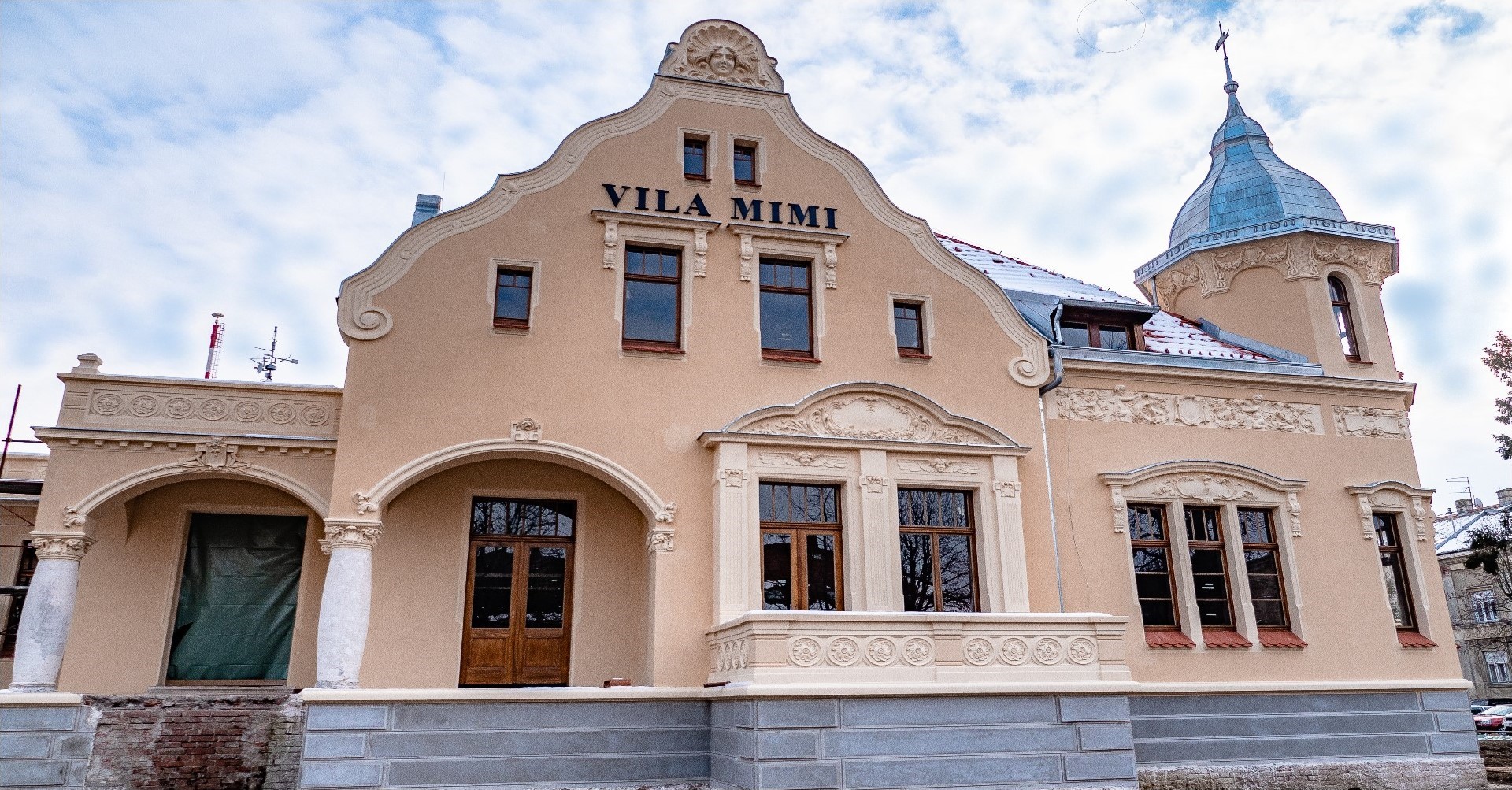
All contemporary images of the renovated Villa Mimi © Damir Janković
Continental Croatia Trains: Inland Opens Up With Green Travel
October 3, 2020 - With charter airlines in a state of flux and Croatia Railways beginning a renewal of their fleet in Slavonia, are continental Croatia trains the eco-friendly and best way to unlock the inland's amazing potential?
Everything changes. Nothing stays the same. Even before 2020 arrived, lifestyles and trends were headed in new directions. Eco-tourism and agro-tourism were two of the fastest-growing areas within the travel sector, this behaviour change a response to concerns about the environment. And nowhere in the country stands better poised to take advantage of this interest than continental Croatia.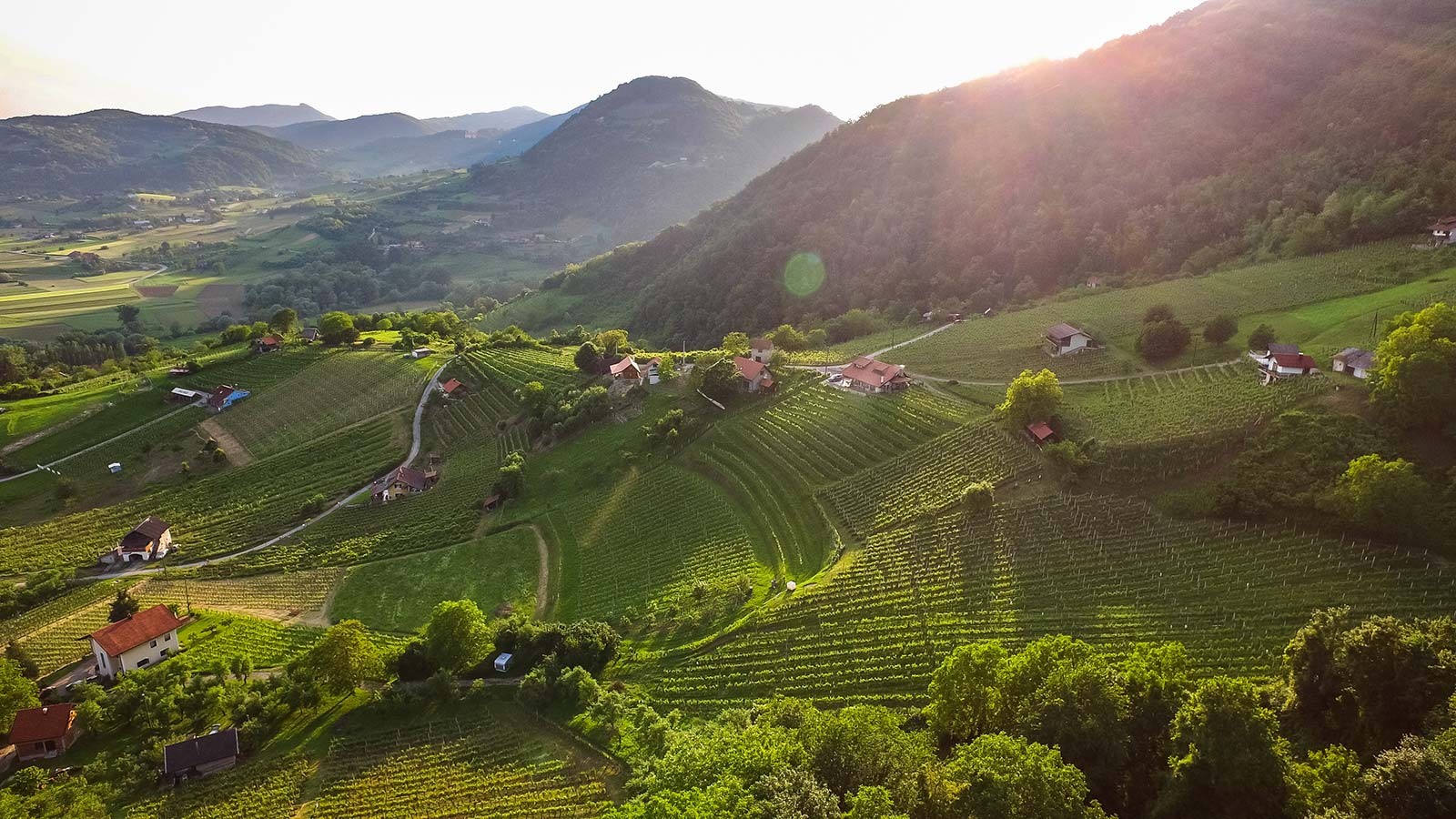 Impossibly pretty Zagorje - the region lies just north of Zagreb and is accessible by continental Croatia trains © Ivo Biocina / Croatia National Tourist Board
Impossibly pretty Zagorje - the region lies just north of Zagreb and is accessible by continental Croatia trains © Ivo Biocina / Croatia National Tourist Board
From the impossibly pretty hills of Zagorje, the peaceful rivers of Karlovac county and the hidden vineyards that surround the capital Zagreb to the vast Pannonian flatlands that stretch to Slavonia, Baranya, Vukovar-Srijem and beyond, the varied topography of continental Croatia is wild, exciting and - by many - wholly undiscovered.
This is land where agriculture and nature thrive side by side, where the stresses of modern-day existence ebb away as you readjust to a way of life that would look mostly familiar to the people who lived here centuries ago. These are places where you can truly be at one with yourself and with your surroundings. In continental Croatia, you often find yourself in an environment that is both timeless and traditional, yet wholly contemporary in regards to its ecological aspirations. And you're never far away from an exciting city environment that you can dip into on a whim – not just Zagreb, but Osijek, Slavonski Brod, Karlovac, Sisak and Varaždin too. To those who really know and love Croatia, Osijek is simply unmissable. It is both the capital of and the doorway to Slavonia and Baranya and should be more accessible by continental Croatia trains. Sadly, international transportation links to the city by air are also quite poor. Improvements in accessibility to Slavonia and Baranya by rail and road are imminent © Romulić & Stojčić
To those who really know and love Croatia, Osijek is simply unmissable. It is both the capital of and the doorway to Slavonia and Baranya and should be more accessible by continental Croatia trains. Sadly, international transportation links to the city by air are also quite poor. Improvements in accessibility to Slavonia and Baranya by rail and road are imminent © Romulić & Stojčić
Unlocking the incredible potential of continental Croatia relies on getting the message out there and facilitating travel to these regions
In recent TCN features we have detailed that motorways within Croatia are among the best in Europe - once you're inside Croatia, travelling by car (or bus) between the regions couldn't be easier. We have also seen evidence of the huge interest in travelling here by rail and using continental Croatia trains.
Of all the modern methods of long-distance travel, rail is by far the most eco-friendly. What better way to begin an environmentally friendly holiday than by arriving on continental Croatia trains? When the country wisely decided to prioritise its internal motorway system, a modern and fast inter-regional rail network was put on the back burner. Nowhere suffers greater from this decision than continental Croatia.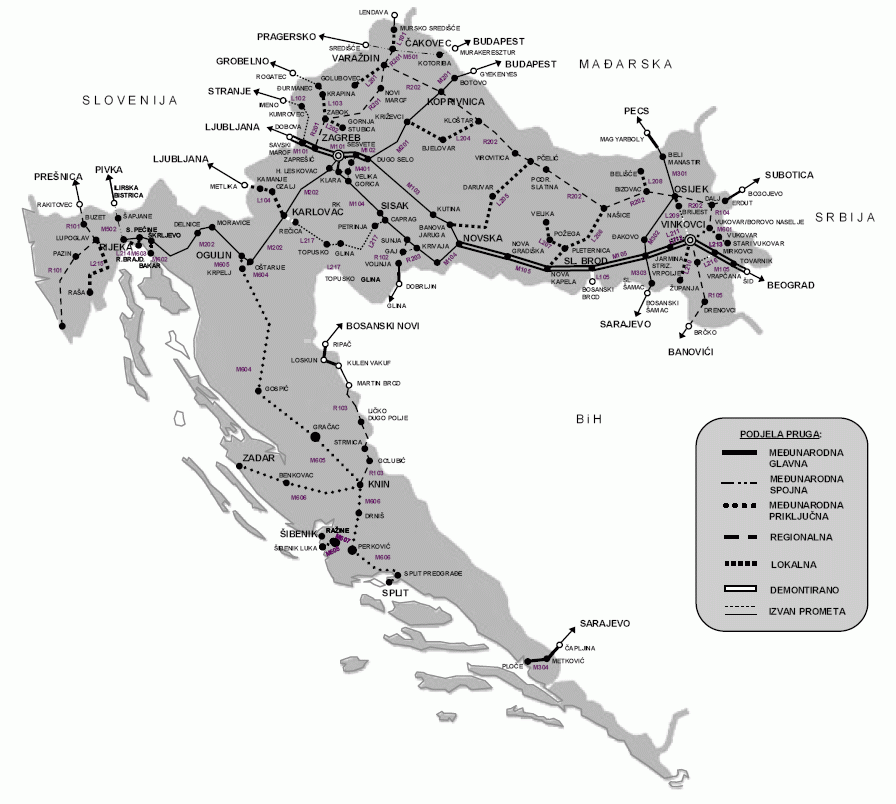 The Croatian rail network © Croatian Official Document uploaded to Wikipedia by Epepe
The Croatian rail network © Croatian Official Document uploaded to Wikipedia by Epepe
The only high-speed line that currently exists in Croatia links Rijeka to Budapest, via Zagreb and Koprivnica. Planned improvements hope to cut journey times between Zagreb and its nearest coastal city to an hour. Same as it ever was - Rijeka was the first Croatian city to be connected internationally by rail. That line also ran into the heart of Austro-Hungary and facilitated upper-class travel to places like Opatija. But does it best benefit the country to invest in more links to the coast or in continental Croatia trains? Well, the inland is not being ignored. Upgrades are being made to continental Croatia trains. This impressive beast actually services the country's coast. But would more investment in the continental Croatia trains network better service more people and help unlock the inland to tourists? Around 70% of the country's inhabitants live in continental Croatia © HŽPP
This impressive beast actually services the country's coast. But would more investment in the continental Croatia trains network better service more people and help unlock the inland to tourists? Around 70% of the country's inhabitants live in continental Croatia © HŽPP
The rail link between Zagreb and Slavonski Brod is so historic that it was once part of the four routes of the Orient Express. It has been maintained to a standard where you can make a relatively quick journey from the capital to Vinkovci via Slavonski Brod. The same cannot be said for rail travel to Osijek, the access point to Baranya and much more. So slow is the connection between Osijek and Zagreb that it has been possible over recent times to reach the Slavonian capital quicker by taking the train to Vinkovci, then the bus to Osijek, rather than travelling direct by rail.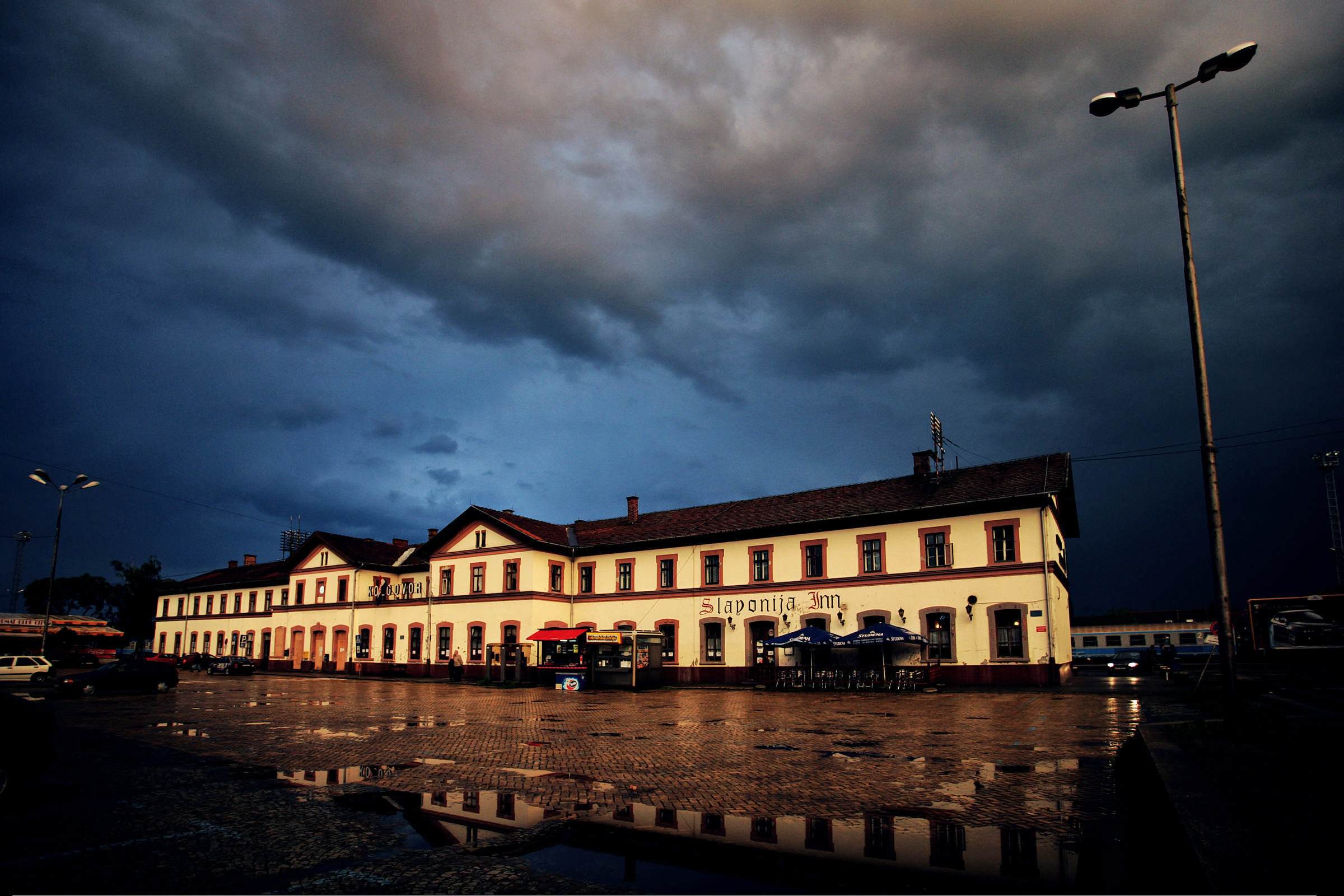 Osijek train station. A renovation to the building is planned for the near future © Romulić & Stojčić
Osijek train station. A renovation to the building is planned for the near future © Romulić & Stojčić
However, in February this year, Croatian Railways introduced four direct daily lines between Slavonski Brod and Osijek. And there will be a new tilting train line that will run between Zagreb to Osijek on Friday afternoon and from Osijek to Zagreb on Sunday afternoon, facilitating student travel. On October 15, the first low-floor train will run between Osijek and Vinkovci as an additional part of the renewal of their continental Croatia trains fleet in Slavonia. The welcome return of Croatia's second-oldest international rail line - linking Osijek to Pécs in Hungary, via Beli Manastir and Baranya - was introduced in late 2018.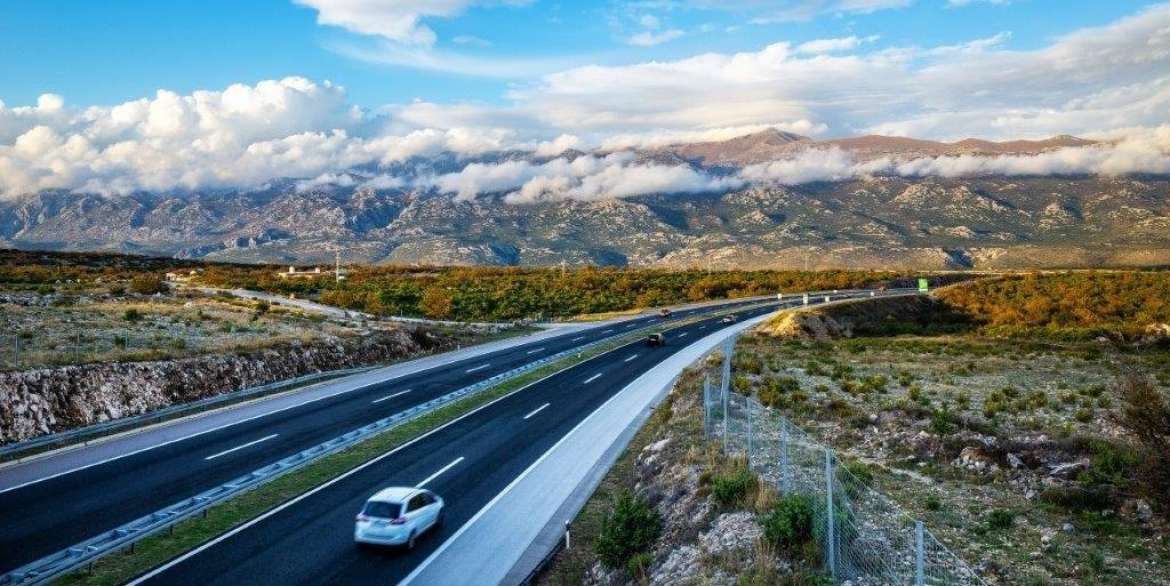 A motorway stretch between Metković and Dubrovnik, integrating the Pelješac bridge and the Croatian segment of the European corridor are the final big remaining projects in a three-decade-long undertaking to give Croatia one of the best motorway networks in Europe. Should Croatia's rail network be next? © Hrvatske Autoceste
A motorway stretch between Metković and Dubrovnik, integrating the Pelješac bridge and the Croatian segment of the European corridor are the final big remaining projects in a three-decade-long undertaking to give Croatia one of the best motorway networks in Europe. Should Croatia's rail network be next? © Hrvatske Autoceste
Access to Slavonia and Baranya will also be massively facilitated upon completion of the European corridor, which will connect North Europe to the Adriatic. Starting in Budapest, it necessitates the building of a bridge near Beli Manastir. Thereafter the motorway will pass by Osijek, connect to the Zagreb-Slavonia motorway near Lipovac, then pass through Bosnia and its capital Sarajevo and on to Ploče.
The removal of budget airline flights to the airport in Osijek remains a hindrance to attracting many international visitors to Slavonia and Baranya. However, with charter airlines facing the greatest uncertainty of all modes of transport at the current time, though their return is a must, it is perhaps now an ambition that should remain more long term. For the immediate future, improvements to rail travel look to be a brilliant way of opening up not only Slavonia, Baranya and Vukovar-Srijem, but also an eco-friendly access point capable of serving the whole of untapped continental Croatia.
For the latest travel info, bookmark our main travel info article, which is updated daily.
Read the Croatian Travel Update in your language - now available in 24 languages
Osijek Have The Best Coach In The Croatian First League Nenad Bjelica
Friday, 4 September 2020 - Dinamo Zagreb's loss is NK Osijek's gain, as the rising Slavonians make a surprise start to the new season, lead by the best coach in the Croatian first league Nenad Bjelica
There has been a taste of optimism in the air of Osijek for a while now. And much of it has been centred around the city's NK Osijek football club. However, expectations have flown through the roof this week as it has all but been officially confirmed that the team will start the impending season under the guidance of the best coach in the Croatian first league Nenad Bjelica.
It is the most surprising move within the Croatian first league since Niko Kranjčar left his boyhood club Dinamo for bitter rivals Hajduk Split in 2005. At the start of last season, Bjelica was the coach of Croatian champions, Dinamo Zagreb.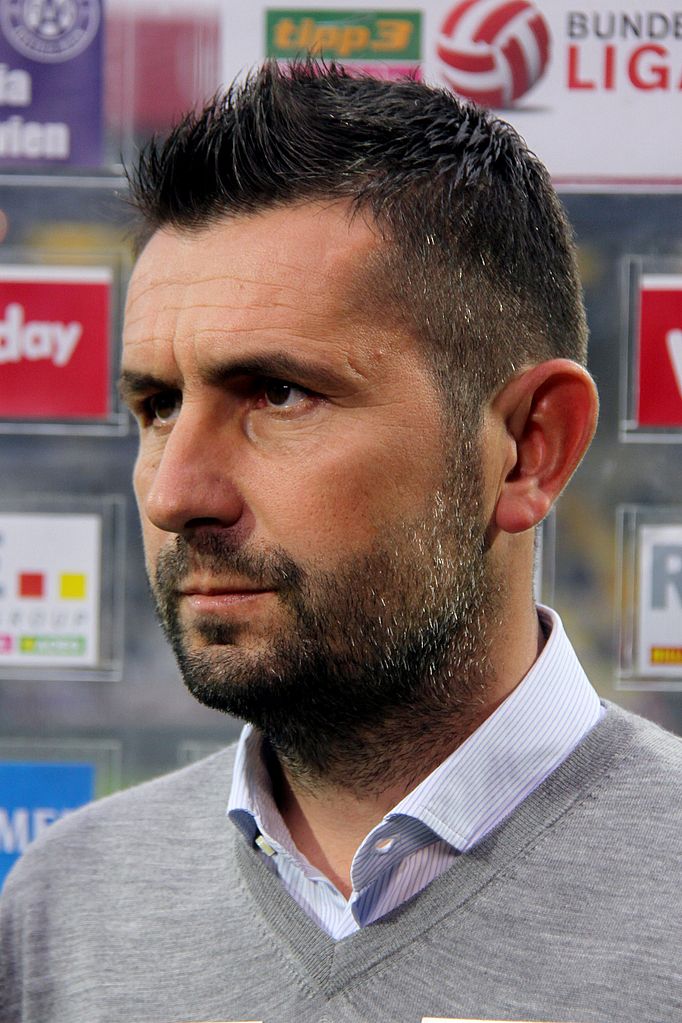
The best coach in the Croatian first league Nenad Bjelica, pictured during his time at FK Austria Wien © Steindy
But, this time, there can be no bitterness directed towards the moving man, no anger assigned to Bjelica for seeking a job in his hometown after his dismissal from Dinamo. Even if you attribute blame to those running the farce that Dinamo Zagreb has become, this latest shame for the club comes at the end of a very long list of grievances. Grievances that Dinamo supporters have proven all too quick to forgive, as soon as their wealthy club again win the league or lift the cup.
In recent years, Osijek has suffered more than any other major Croatian city from population decline. The streets of its westerly lying centre are often deserted in comparison to how the city was 20 years ago. And that's not just because of out-of-town shopping centres. Many young people born here, unable to find work for their considerable talents and skills, can now be found in Germany or Ireland. An accepting but unhappy resignation lies with those who've remained. It shouldn't be like this. Those emerging from the city's excellent university are among the best educated in Croatia. The computer sciences and programmers who graduate from Osijek are second to none.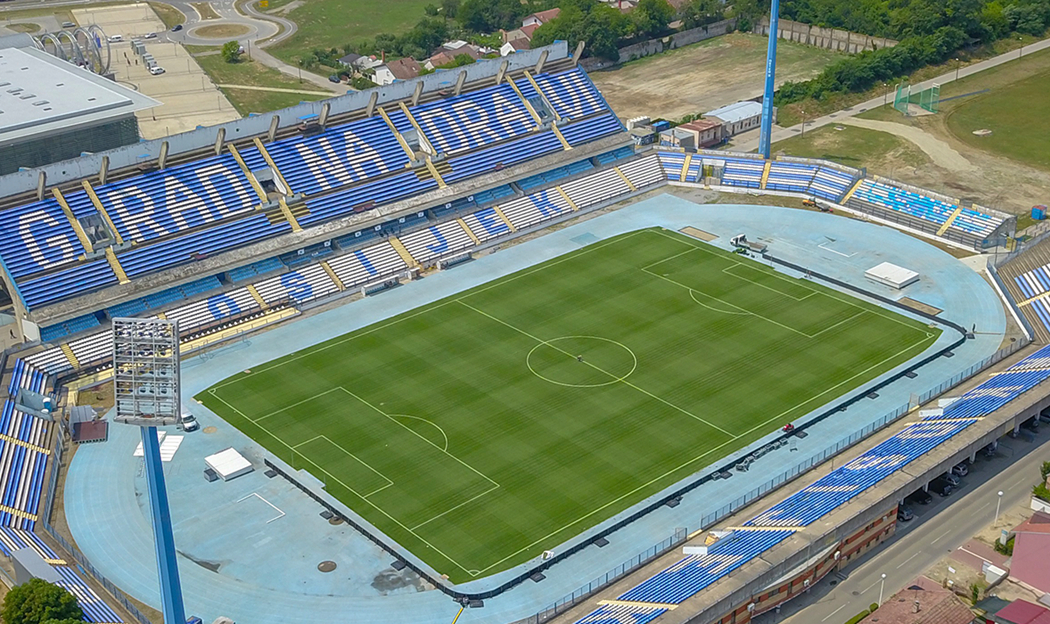
Gradski Vrt, on the border of Sjenjak, in Osijek. It is the current home of NK Osijek. It will be used for the B team when the new stadium is finished © NK Osijek
One of the chief mood lifts for the men deserted by old school friends has been the attendance of Gradski Vrt, which currently remains NK Osijek's home ground. Not so long ago, it was a visit that only added misery. Though they are one of only four clubs never to have been relegated from the Croatian first league, NK Osijek was facing financial ruin as recently as 2016. But, then, Hungarian businessman Lőrinc Mészáros and Croatian Ivan Meštrović bought majority shares in the club.
Under the new regime, the squad was improved and a can-do spirit returned to the stands at Gradski Vrt. The club finished 4th in the league in 2017, just after celebrating the 70 year anniversary of playing under the name NK Osijek. It was their highest league finish in nearly 10 years and took them to qualifying matches for the 2017–18 UEFA Europa League. There, they beat Santa Coloma, Luzern and even former European champions PSV before their run was halted by Austria Wien. It hardly mattered. The ambition and optimism had returned for good. You could feel it throughout the city, not least when rumours of a brand new stadium began to filter through the stands.
Securing fourth in the domestic league the next year again took Osijek to the UEFA competition and in April 2018, plans for the impressive new Pampas Stadium were revealed. A state of art UEFA category 4 stadium for 12,000 rain-shielded fans, the new ground will be fully compatible with televised coverage of international competitions. This is an indicator of Osijek's ambition. Not a day goes by when football fans from the city - indeed, from all over Croatia - check on the progress of construction.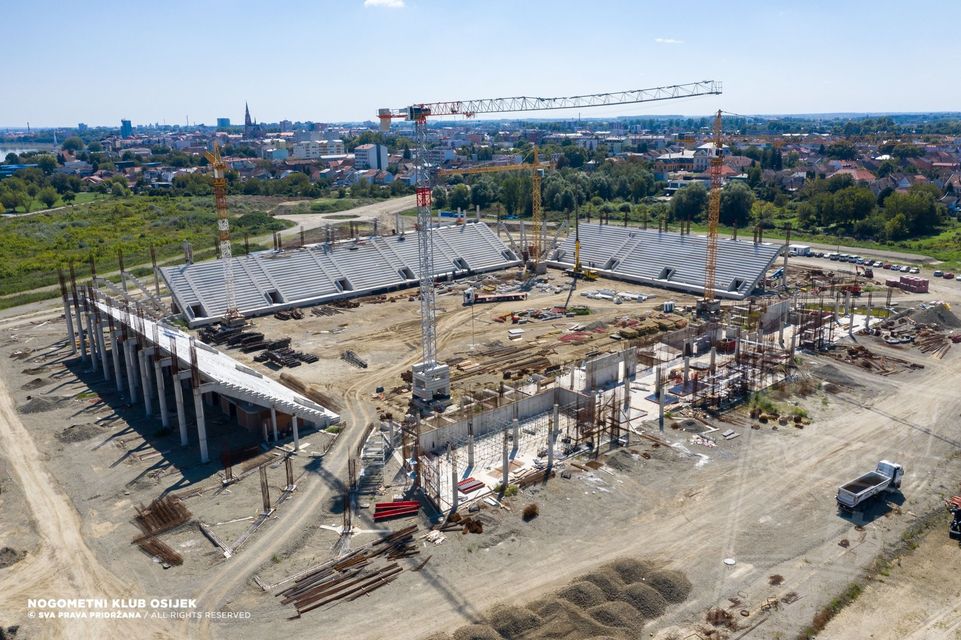
The progress of construction of Osijek's new ground is being watched by football fans across Croatia. it is a fitting home for the best coach in the Croatian first league Nenad Bjelica © NK Osijek
That the team should be starting the new season with the best coach in the Croatian first league, Nenad Bjelica, is yet another measure of that ambition. But, unlike the visible rise of the new stands, few saw this one coming. After the mess of his departure from Dinamo Zagreb, it had been anticipated that Bjelica might go to La Liga or Serie A. He's certainly good enough.
A former player for NK Osijek, Bjelica spent four early seasons at his hometown club before moving to Spain to play for Albacete Balompié, Real Betis and Las Palmas. Following a spell of injuries, he returned to Osijek for two seasons and featured for them in the UEFA Cup competition. He played the last eight years of his career as a professional in Germany and Austria, before retiring in 2008. He bowed out after having represented Croatia nine times as part of the national side.
He began his managerial career at the same club from which he retired as a player, Austria's FC Kärnten, but by 2013 had moved to Austria Wien where he helped secure their qualification for the Champions League group stage. He spent time in Italy and Poland before returning to the Croatian first league Nenad Bjelica signed for Dinamo Zagreb in 2018.
After a successful first year in charge, most were of the opinion that in the Croatian first league, Nenad Bjelica was the best coach. After guiding the team through a good Europa League campaign, Bjelica's successes resulted in attaining the highest number of qualifying places ever for Croatian domestic teams in European competition. He returned Dinamo Zagreb to the Champions League for the first time in three years before his winning run at the club was halted by their latest debacle.
How NK Osijek's new Pampas stadium complex will look when complete © NK Osijek
How they could have let him slip through their fingers is eye-raising and yet, at the same time, not surprising. This is Dinamo Zagreb. Their supporters are resigned.
“Honestly, I am so happy for Osijek,” frustrated Dinamo Zagreb supporter David Kutleša told TCN upon hearing of the appointment.
“He accepted Osijek? What a legend!” said another, Martin Žunec. “This next season is going to be sick (great).”
For too long have the tarnished successes of Dinamo Zagreb taken the full limelight in Croatian domestic football. Though eminently predictable, their lifting of consecutive cups has nevertheless brought cheer to supporters of a club riddled with trouble. Such domestic achievements may not immediately follow Bjelica to Slavonia. But, it barely matters right now. NK Osijek will start the new season with the best coach in the Croatian first league, Nenad Bjelica. In his acceptance of this appointment, it is to a building momentum of optimism that Bjelica is contributing. And nowhere is that more needed than Osijek.
The official announcement of the Croatian first league Nenad Bjelica's appointment to NK Osijek is expected on Saturday 5 September 2020
For the latest travel info, bookmark our main travel info article, which is updated daily.
Read the Croatian Travel Update in your language - now available in 24 languages
49-Year-Old Man Stabs Two Children In Darda And Mece, Near Osijek
August 17, 2020 -Two shocking incidents, one in Darda, one in Mece, happened at around 10am this morning. Police have arrested a man.
Two children were this morning stabbed in the areas of Darda and Mece, just north of Osijek. The incidents happened at around 10am. The injured children were taken to the Clinical Hospital Centre in Osijek for treatment.
Police took a 49-year-old man into custody at approximately 10.40am. He is described as being a Croatian national. Further details about the man, such as his name and ethnicity, have not yet been revealed. It is understood police are not looking for anyone else in connection with the crime.
Local portal SiB.hr are reporting that the 49-year-old first stabbed a boy with a screwdriver at the NTL store in Darda, then returned to Mece by bicycle where he knocked down a girl on a hoverboard before stabbing her repeatedly.
Investigations into the incidents are taking place simultaneously in Darda and Mece, lead by the Deputy County State's Attorney from Osijek in cooperation with Osijek-Baranja Police. After being examined, one of the children was released from hospital and sent home with minor injuries. The other has been kept in for treatment. Police expect to release more information in the next 24 hours.


